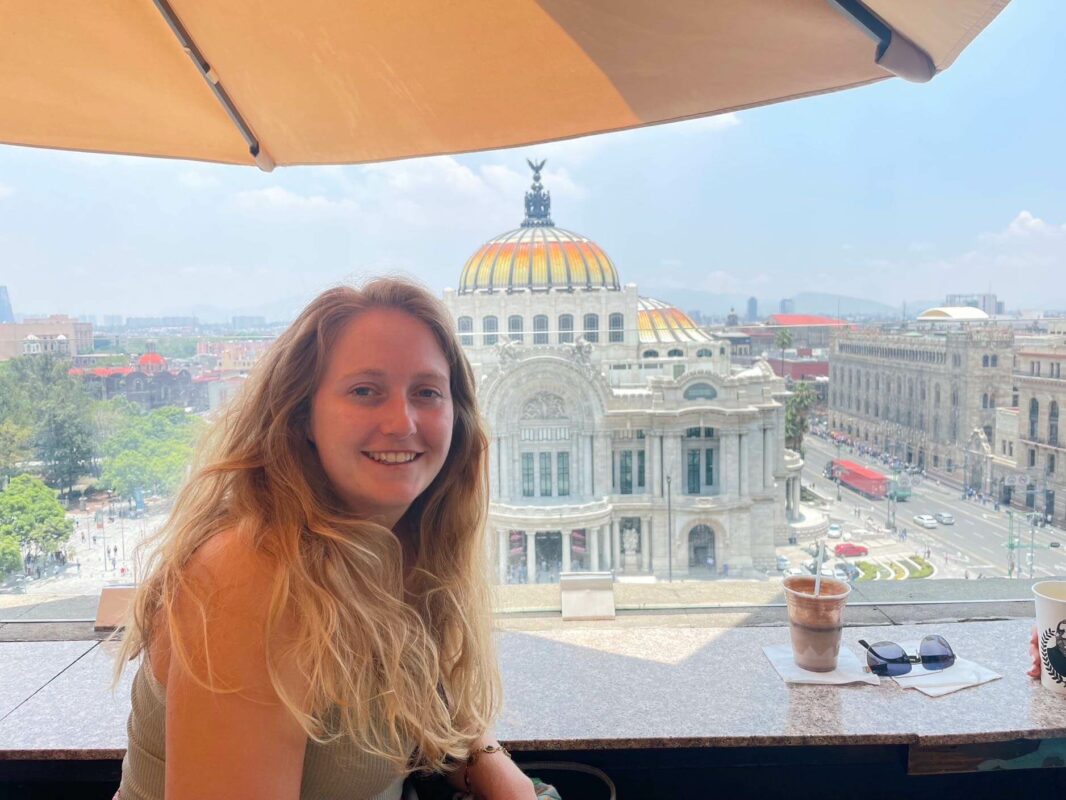How to describe Mexico City’s Historic Center?
Well, it’s a place of contrast. It’s hectic, urban, and a little gritty in parts, but it’s also home to incredibly grand historic buildings making up the World Heritage Site that includes Xochmilco waterways. There are markets packed with modern flashy gadgets – mostly knockoffs – alongside historic establishments selling the same quality products for decades.
There are countless major tourist attractions, plus fascinating hidden gems that most visitors never make it to.
It’s where history and tradition meet beside Mickey Mouse headphones. Where vendors flip 10 peso tacos in front of marble palaces. Unlike the beautiful but curated Roma and Condesa neighborhoods popular with foreign expats, this is the real Mexico... and it’s somewhere you NEED to visit!
Mexico City downtown map
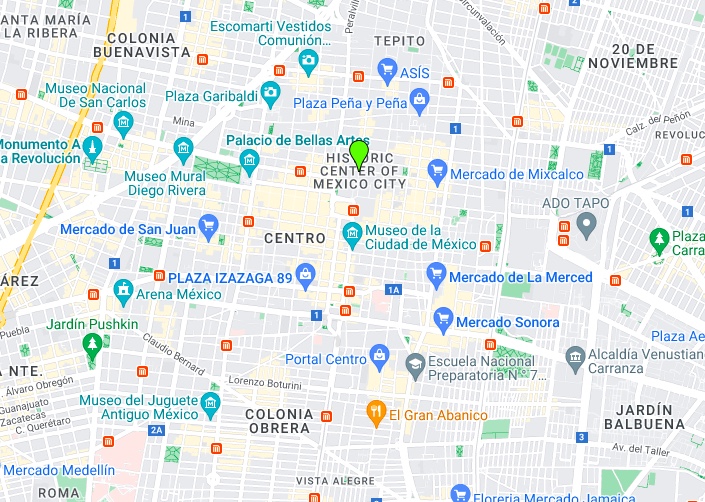
The historical name for the center of Mexico City is Centro Historico or simply Centro. It roughly stretches from Juarez station in the west to Plaza Garibaldi in the north and Pino Suarez station in the south.
How to get to the Historic Center of Mexico City
Metro: the station Bellas Artes will bring you to the palace of the same name while Zocaclo/Tenochitlan will take you to the ruins. Other stations serving different areas of Centro are Isabel la Catolica, San Juan de Letran, Salto del Agua, and Juarez. Journies cost just 5 pesos and you can buy a Metro card in any station.
Bus: the Metrobuses (that run along a wire) and regular buses service Mexico city center. Metrobus journies cost 6 pesos and you can pay with a Metrocard.
Taxi: if you’re staying in the Roma or Condesa areas or surrounding boroughs like Escandon, you can arrive by Uber or Didi for 80-140 pesos depending on traffic. If you’re staying in Juarez neighborhood, you’re close to Centro and can get a taxi for as little as 50 pesos or simply walk.
On foot: I often walk from Roma Norte which takes 40 minutes to 1 hour depending exactly where I’m going.
Note about traffic – I try to avoid traveling at rush hour which is approximately 7.30am-10am and 4-7pm because the streets are grid-locked and public is transport packed! I guess that’s what you can expect from a city of 22 million.
How to get around Centro Historico
I would suggest exploring on foot because there’s always traffic. Parts of Centro – like Avenue Francisco Madero – are pedestrianized. Walking from one end of Centro to the other takes 25 minutes but there are so many attractions along the way that you’ll never be walking for that long without stopping.
Things to do in Mexico City’s Historic Center
If you just have a day in Centro, here’s what I’d recommend doing. These are the top places for sightseeing. If you tick them off, add some of the other museums and galleries I’ll mention next, plus some of the fantastic places to eat.
Note about Mondays – almost all the museums, galleries, and attractions are closed on Mondays so it’s the worst day to visit Centro. Also, most of the museums are free on Sundays but they’re very crowded.
Palacio de Bellas Artes (Palace of Fine Arts)
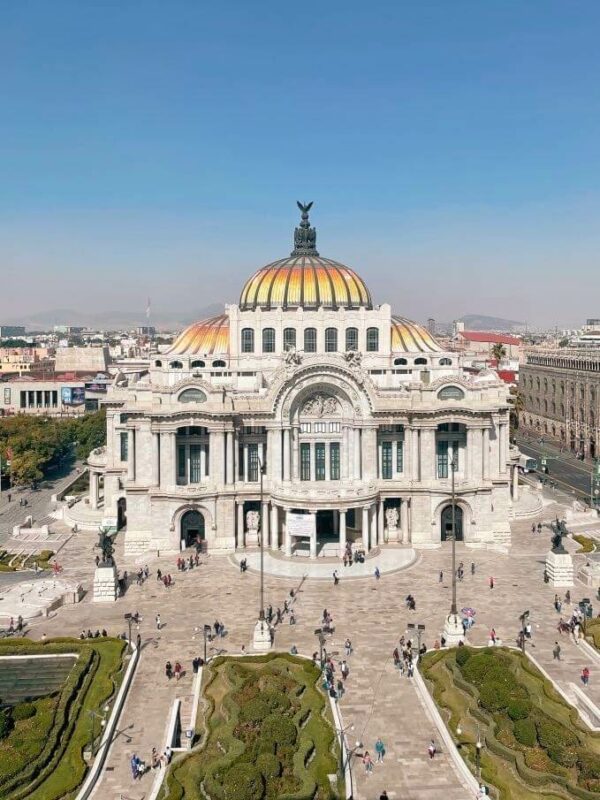
The number 1 attraction in the city center – if not the entire city – is the Palace of Fine Arts. This majestic building is a recognizable emblem of the city with its Arte Nouveau facade, grand pillars, white marble, and orange domed roof. Architect Adamo Boari began construction in 1904 but it took over 30 years to finish, partly because of the Mexican Revolution.
Inside, are several galleries and exhibition rooms with work by famous Mexican artists like Diego Rivera. On the top floor is his fascinating Man Controller of the Universe Mural, the original destroyed by John D Rockefeller Jr who was furious to find the mural he’d commissioned for the MoMa contained communist references.
Note – for those interested in Diego murals in Centro, keep reading for a whole section on this…
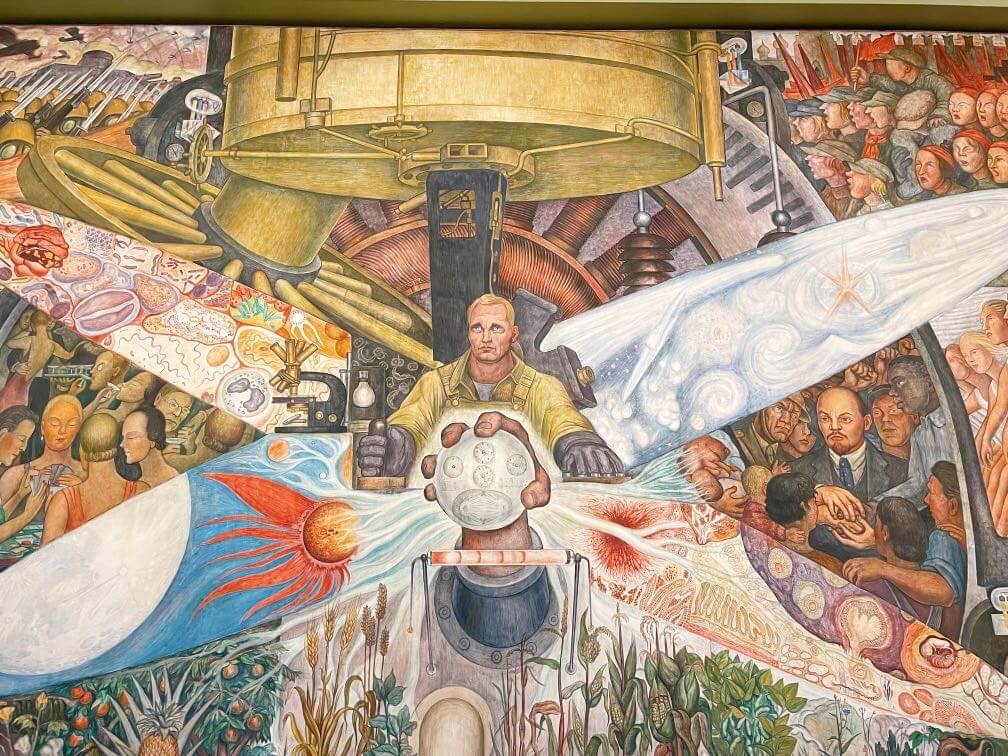
It’s not just a museum but a cultural event space. The National Theater is located inside, used by the national ballet, orchestra, and dance companies. One of the best things to do in Centro at night is catch the Folklore Ballet (Ballet Folklórico). Since the show is language-free, it’s a fun option for non-Spanish speakers.
The theatre itself is stunning with bronze statues of Tlaloc and Chaac (Aztec and Mayan gods) and a 24-ton crystal curtain made by Tiffany’s.
Another fun option is the Night at the Museum event that happens throughout Centro on the last Wednesday of the month. Entry to many museums, including Bellas Artes, is free and there are live orchestras.
Entry price: You can go into the downstairs hall for free or buy a 75 peso ticket to see the exhibitions on the top 2 levels. Tickets for the Folklore Ballet start from 369 pesos.
English signs? Per room but not per exhibit.
Opening times: 11am-5pm, Tuesday-Sunday (closed Mon).
Alameda Central
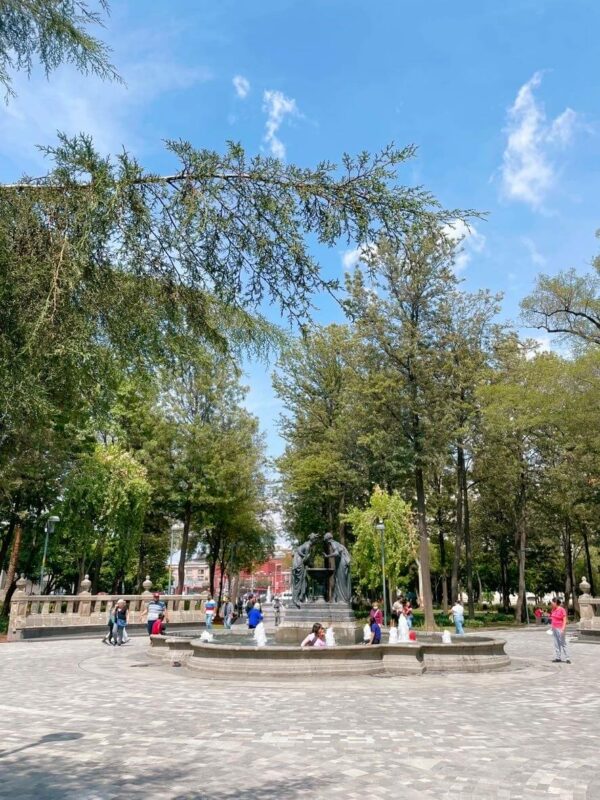
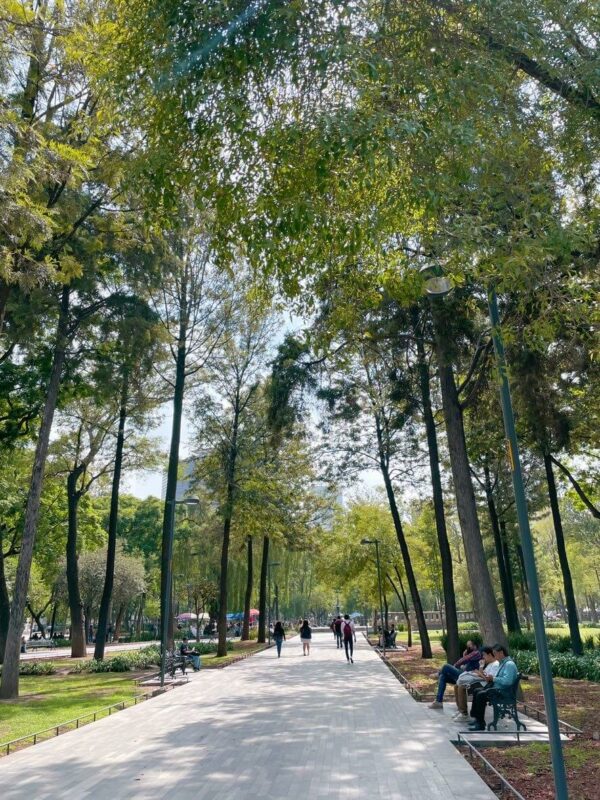
Beside the palace is this pleasant square with fountains, benches, and plenty of trees. It’s always busy with people of all ages enjoying the outdoors. It’s a great place to relax during a busy day sightseeing in Centro Historico.
The oldest public park in the Americas dating back to 1592 borders several museums and some great restaurants like El Cardenal and Bosforo. Beside the Fuente de Mercurio statue is a small mall where you can drink decent coffee at Mandrake or have a rooftop lunch or cocktail at La Azotea.
Chinatown (Barrio Chino)
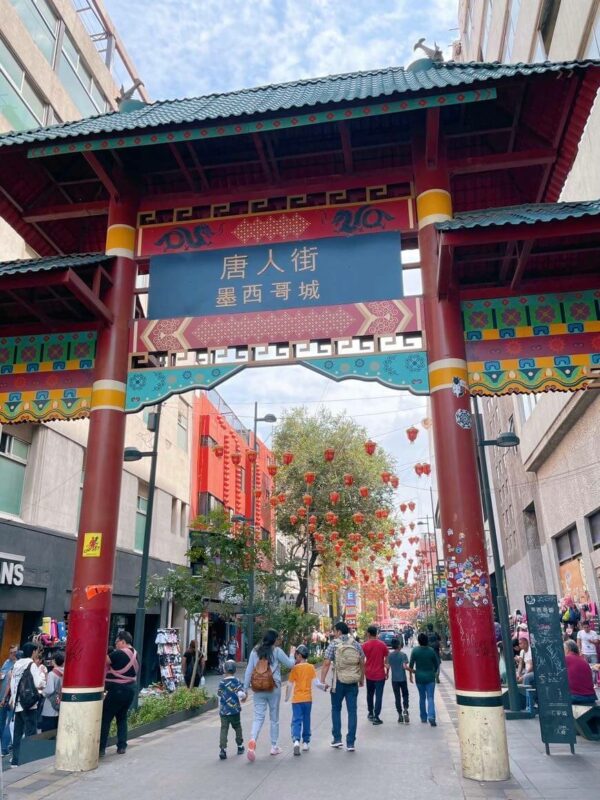
A notable part of Mexico City’s downtown is Chinatown, marked by giant red arches. However, you wouldn’t visit the Historic Center of Mexico City just to visit. If you’ve been to other Chinatowns in the world, it’s pretty disappointing with inauthentic food (perhaps because none of the people working there seem to be Chinese). It’s also very small.
Still, it’s worth wandering through when visiting other attractions in the Zocalo.
The House of Tiles (Casa de los Azulejos)
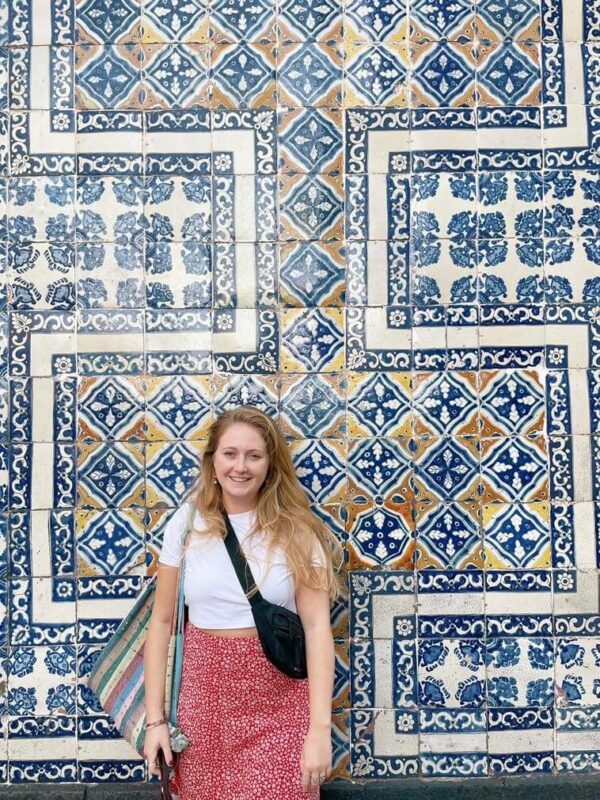
This is one of my favorite things to do in Centro Historico, stunning from the second you lay eyes on it. As the name might suggest, the House of Tiles is a huge building covered in… you guessed it, beautiful tiles!
The blue, yellow, and white Talavera tiles date back to the 1700s when the residence was home to the Counts of the Valley of Orizaba. One theory is that they were inspired by the buildings of nearby city, Puebla, whereas another theory goes that a father and son fell out when the father thought his son was good for nothing. The son decorated his home with exquisite tiles to prove him wrong!
In later centuries, the building was lived in by intellectuals and then served as a worker’s house during Mexico’s brush with communism. When this ended, it was brought by a cheap chain restaurant called Saborns serving classic Mexican dishes to this day.
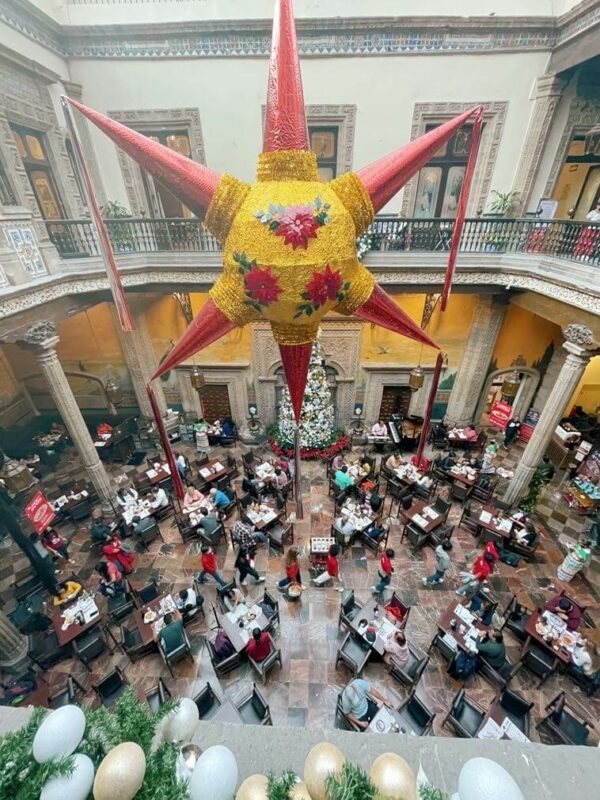
It’s worth going for a wander inside the building to admire the beautiful peacock murals.
It’s interesting – and alarming – to notice how much Mexico City has sunk since Casa de Azulejos was built. When walking up the stairs, you can’t help but notice how much they slope.
A visit to the House of Tiles is worthwhile but doesn’t take long. After you’ve seen the Palace of Fine Arts and Alameda Park, swing by his beauty before continuing down Avenue Francisco Madero walking street toward…
Templo Mayor ruins
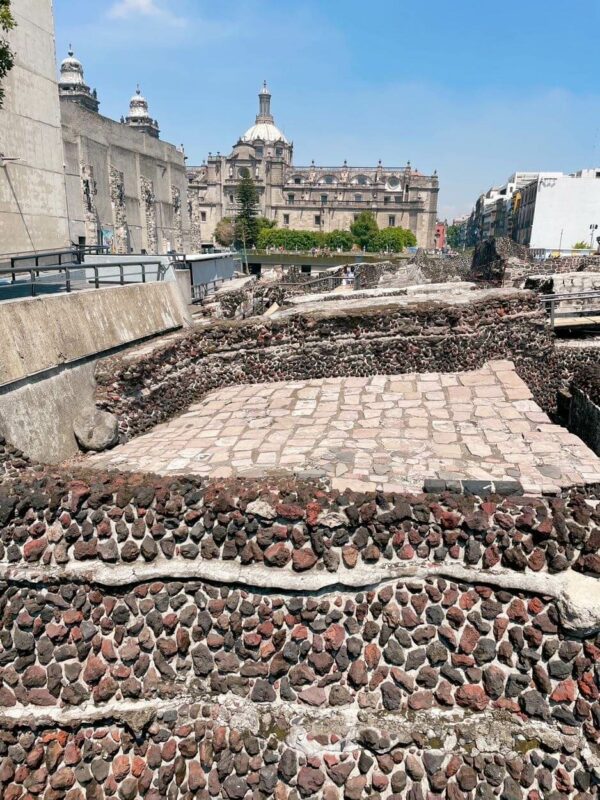
Another of the most important attractions to visit in the Historic Center is Templo Mayor (Great Temple), the remains of the ancient Aztec city of Tenochtitlan, now a UNESCO World Heritage Site. In the 1500s, over 200,000 people lived here making it the biggest city in the Americas – until Hernan Cortes arrived and the Spanish Empire took over.
The original name of the city, Tenochtitlan, comes from the Nahuatl word for ‘among the prickly pears growing among rocks’. Around 60,000 traders from miles around visited each day for the legendary market, and the city was connected by canals, all leading to the ‘chinampas’ (islands) of Xochimilco where fresh produce was grown.
It remains unclear when exactly Templo Mayor was built but March 13, 1325 was picked as the ‘official’ day on which to celebrate the city’s anniversaries. The 700th one is coming up in 2025.
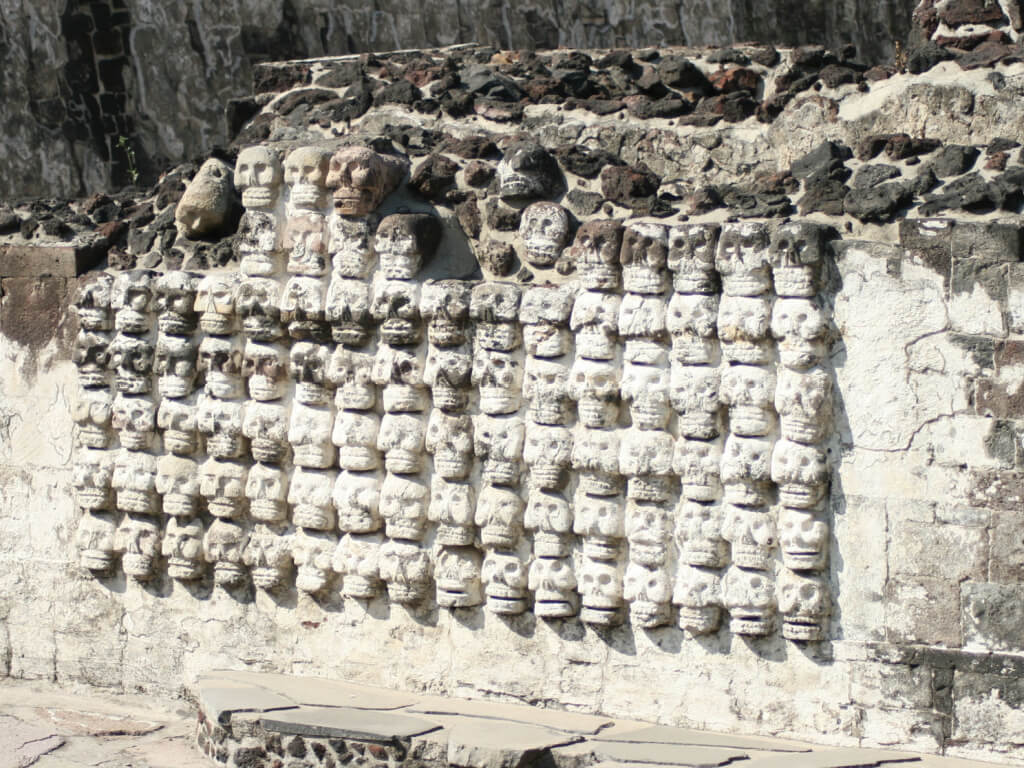
Visitor’s details: you can see the ruins for free from boardwalks either side, however you won’t learn much without going inside the small museum underneath. It has signs in English and Spanish so, if you’re interested in the history (including ancient gods like Huitzilopochtli, the god of war and the sun, and Tlaloc, the god of rain), I’d recommend a trip inside for 90 pesos.
Opening times are 9am-5pm daily (closed Mon).
Centro’s underworld
Underneath modern-day Centro is an underground world, still only semi-discovered. In 2015, renovations on a building beside the Cathedral led to a rack of 700 sacrificial skulls being discovered alongside remnants of posts where they would have been displayed by the Mexica people.
To this day, when maintenance work needs to be done on water pipes and electric cables, an architect needs to be present to ensure no ancient relics get destroyed!
Mexico City Metropolitan Cathedral
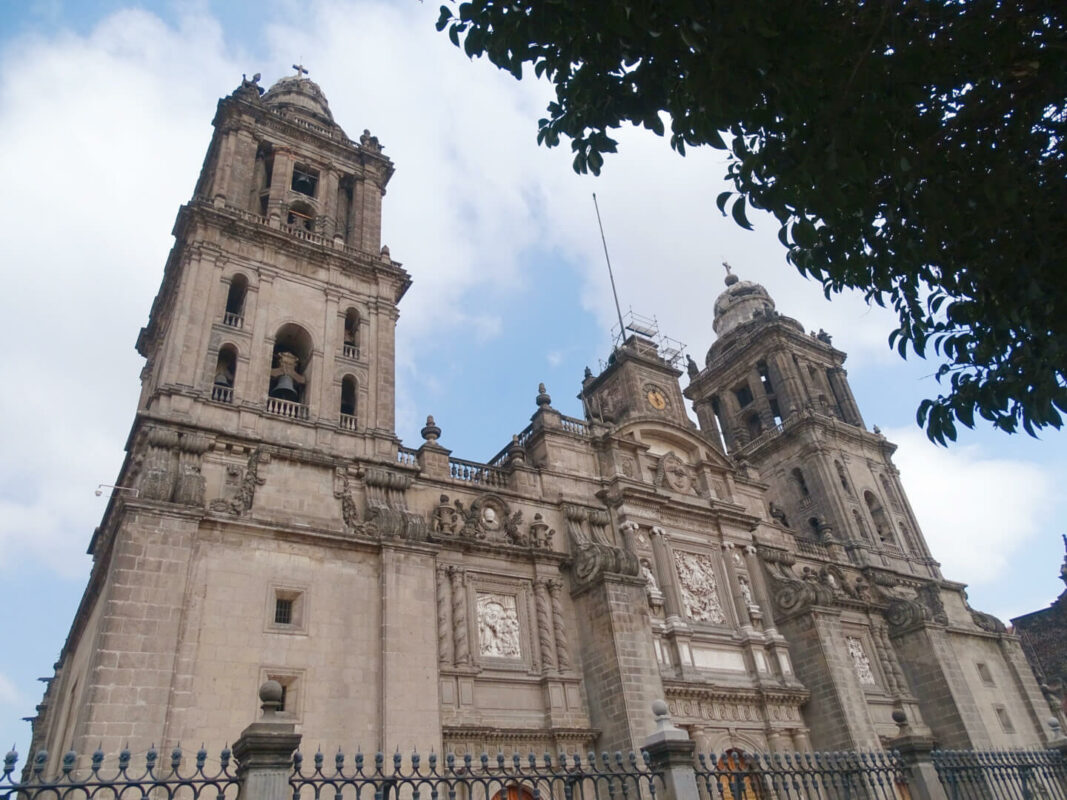
At the heart of Mexico City’s Centro Historico (just moments from Templo Mayor) and Plaza de la Constitución with its giant flag is the Metropolitan Cathedral, built from rocks pillaged from the ruins of Tenochtitlan. Specifically, it’s thought to be built on top of a shrine to Quetzalcoatl, meanwhile, there are known to be remnants of the Pyramid of Tonatiuh underneath.
Despite this tragic history, it’s a popular place to visit in the Historic Center of Mexico City especially for religious locals. If you pop inside, the rush of the Zocalo is replaced with people quietly sitting in prayer.
As is to be expected for Mexico City’s biggest cathedral (and the oldest in all the Americas), it’s very grand inside with tons of gold decorating the alters.
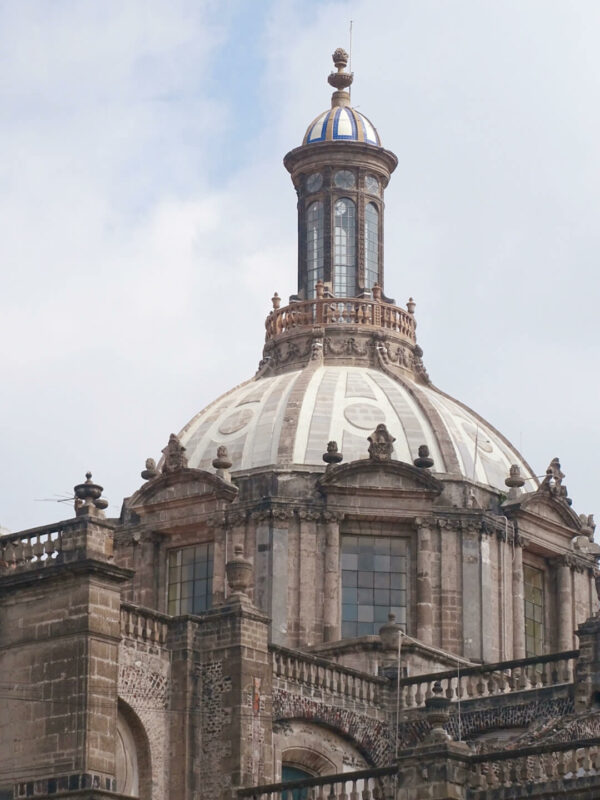
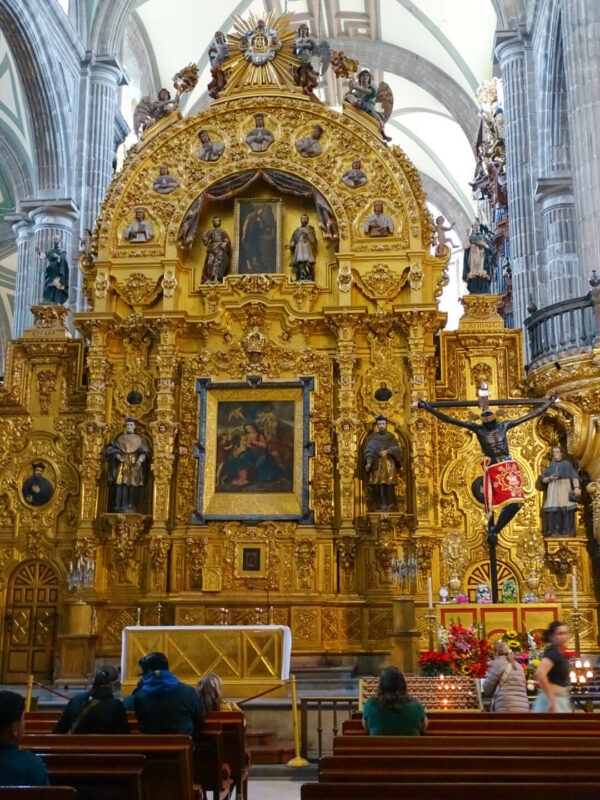
You can go inside but no flash photography or food is allowed; there’s also a section where no photography is allowed at all – keep an eye on the signs.
Torre Latinoamericana
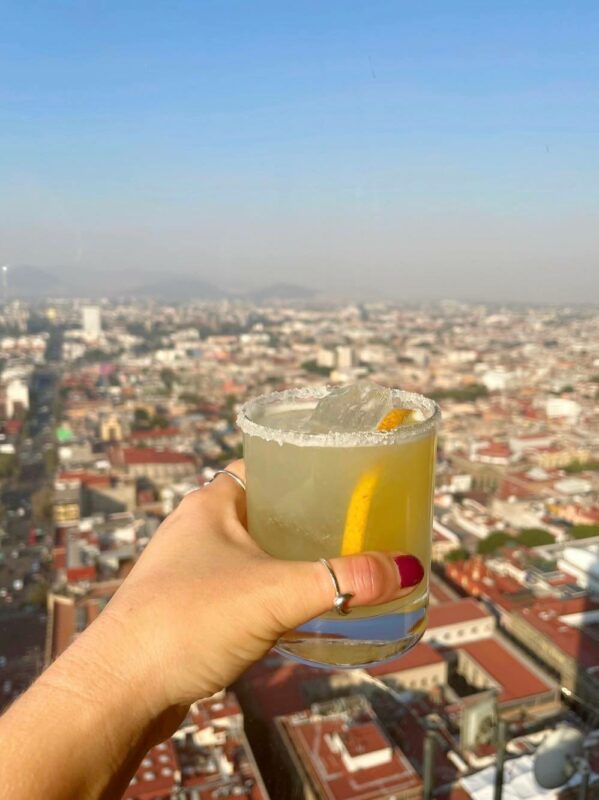
When it was built in 1965, the Torre Latinoamericana was the tallest building in Latin America. Although that title is now long gone, it’s still one of the most popular tourist attractions in the Historic Center of Mexico City thanks to an observation deck on the (top) 44th floor and cafe/bar just a couple of levels below on the 41st floor.
Since entry to the Mirador Tour Latino deck costs 175 pesos (including entry to the museum), I’ve only visited the bar. Entry is free and you can easily get a cocktail for less than the price of the viewing deck. Seems like a no-brainer to me!
Opening times: 9am-10pm.
Plaza Garibaldi (mariachi bands)
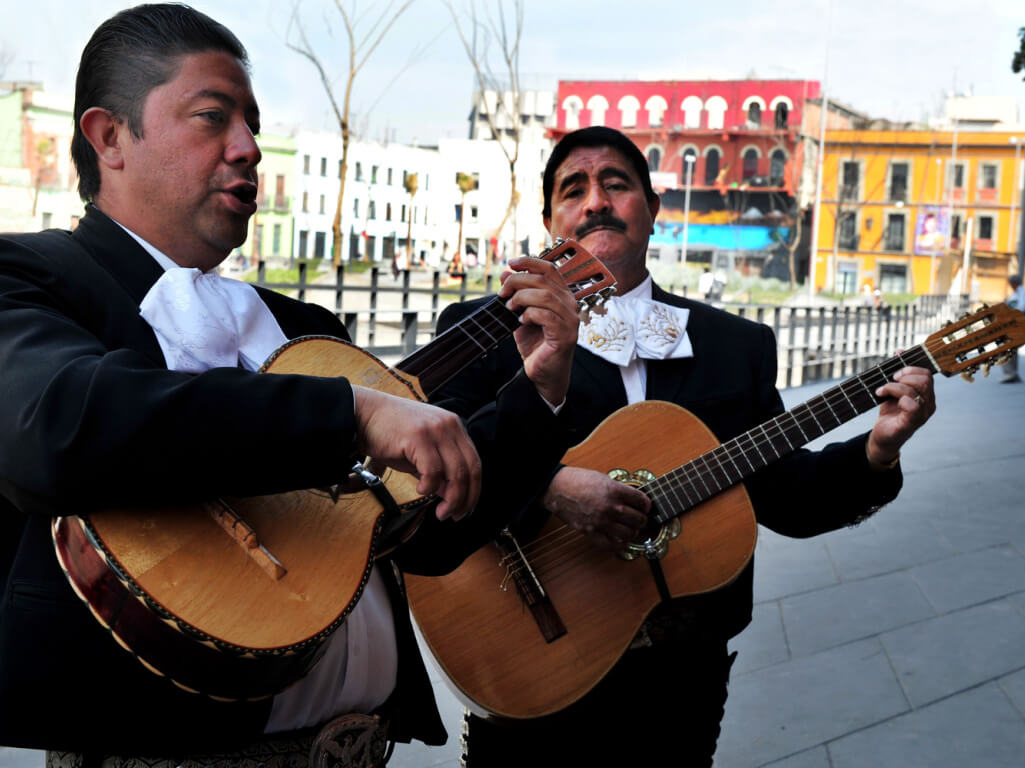
To the north of Centro, Plaza Garibaldi is a slight detour from the other downtown CDMX attractions but worth a visit to watch mariachi bands perform wearing traditional attire. According to legend, a man from Jalisco (the home of mariachi) opened a cantina and hired a band to play. Ever since, the square has been renowned for traditional music.
A word of warning is that Plaza Garibaldi is not an especially safe place at night so it’s advisable to visit before 6pm or at least have a clear exit strategy (for example Uber) rather than wandering the side streets near the plaza.
Admire the Gran Hotel ceiling
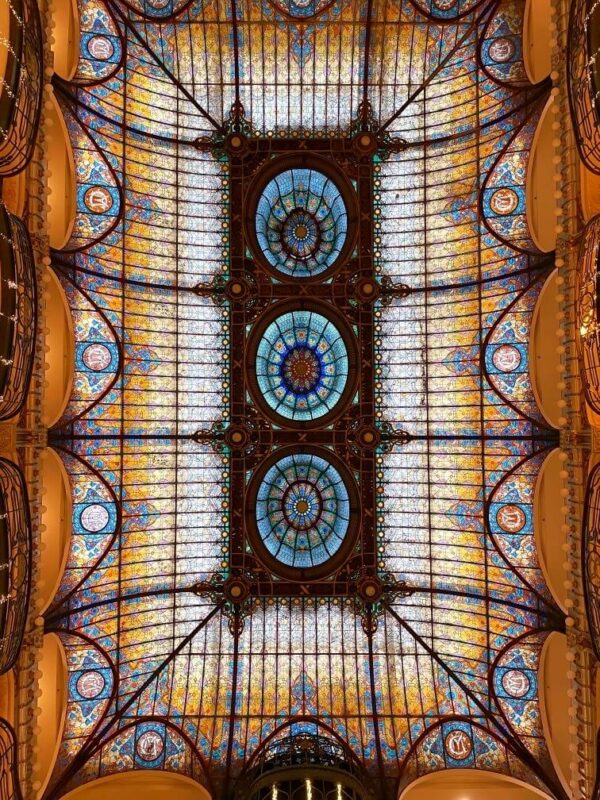
One of the most spectacular buildings in the city is the Gran Hotel, built between 1895 and 1899 according to designs by French architect, Jacques Grube. The real highlight is the Tiffany glass ceiling, but the huge chandelier and ornate elevator are also breathtaking.
Staying overnight is expensive and so is dining at the upstairs restaurant (and I hear the food isn’t great despite the high price tag), but it’s free to pop inside and admire the lobby.
Museums in Centro Historico, Mexico City
This is a city packed with museums (estimates vary but it’s thought Mexico City has over 150). I often hear people say CDMX is the city in the world with the most museums after Paris, although this doesn’t seem to be verified anywhere official.
There are museums all over the city with several of the top galleries in Chapultepec Park, not to mention the famous Frida Kahlo House in Coyoacan. But when it comes to the Historic Center, these are some of the best museums to visit…
Post Museum (Museo Palacio Postal)
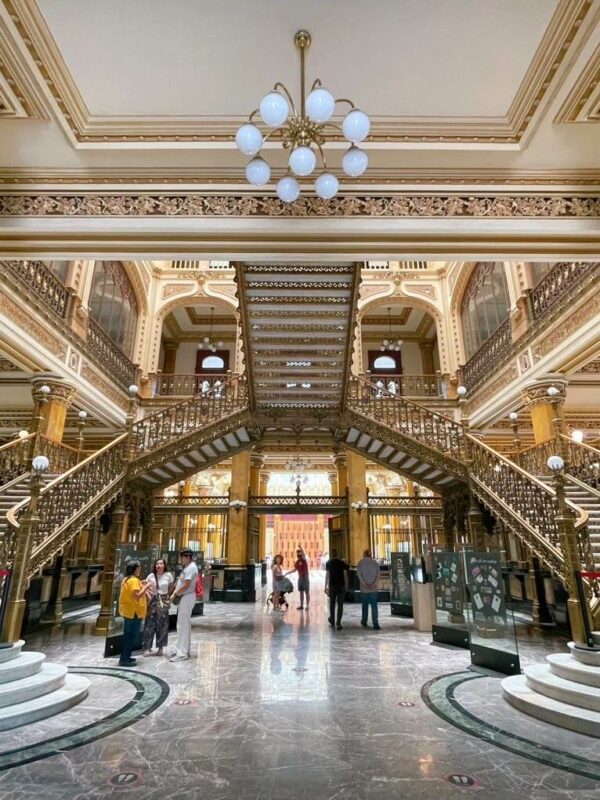
The Museo Palacio Postal, also known as Palacio de Correos, isn’t your typical museum: it’s still a working post office to this day. It may seem like a strange tourist attraction but stay with me… It’s overwhelmingly beautiful!
Like many of the grand European-style buildings in the capital, this was the brainchild of ex-president, Porfirio Díaz. Gold, marble, and chandeliers give the palace its elaborate look, while relics like the country’s first stamp have historical significance.
At one side of the building, locals line up to post packages, while at the other, tourists marvel over the majestic details and read informative signs. Entry is free and you just need 15 minutes or so to look around.
Opening times: 10am-5pm, Tuesday-Sunday; 9am-3pm, Saturday (closed Mon).
Memory and Tolerance Museum
This unusual museum offers something the others don’t: a look into the sadder parts of history including discrimination and violence throughout history. With a focus on human rights, it’s not an upbeat place but an important one.
Signs are just in Spanish at the Memory and Tolerance Museum so you’ll want a decent level to understand the complex subject matter. Entry costs 115 pesos.
Opening times: 9am-6pm, Tuesday-Friday; 10am-7pm, Saturday & Sunday (closed Mon).
Museum of World Cultures
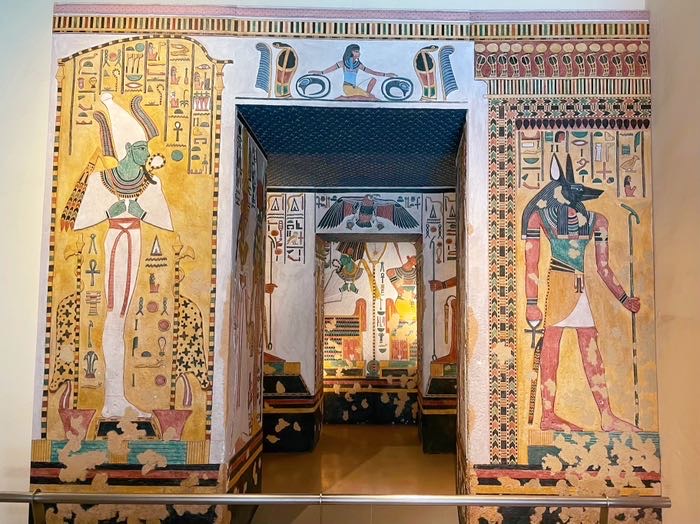
The National Museum of World Cultures is in an old colonial mansion with a beautiful courtyard garden. It’s a great place to escape the chaos of the Historic Center.
The various rooms are dedicated to cultures from around the world such as the Egyptians and ancient China and Japan. Signs are in Spanish only. Entry is free!
Opening times: 10am-5pm, Tuesday-Sunday (closed Mon).
Museo del Tequila y Mezcal
Beside Plaza Garibaldi, the Museo del Tequila y Mezcal offers an insight into Mexican spirits – and the chance to try them! Entry is just 50 pesos, plus whatever you choose to consume.
Opening times: 11am-10pm.
Art galleries in Centro Historico, CDMX
There are some fantastic galleries in Mexico City ranging from modern to historic. The first is my favorite but I’ve had the pleasure of visiting all the places below…
Museo de Arte Popular
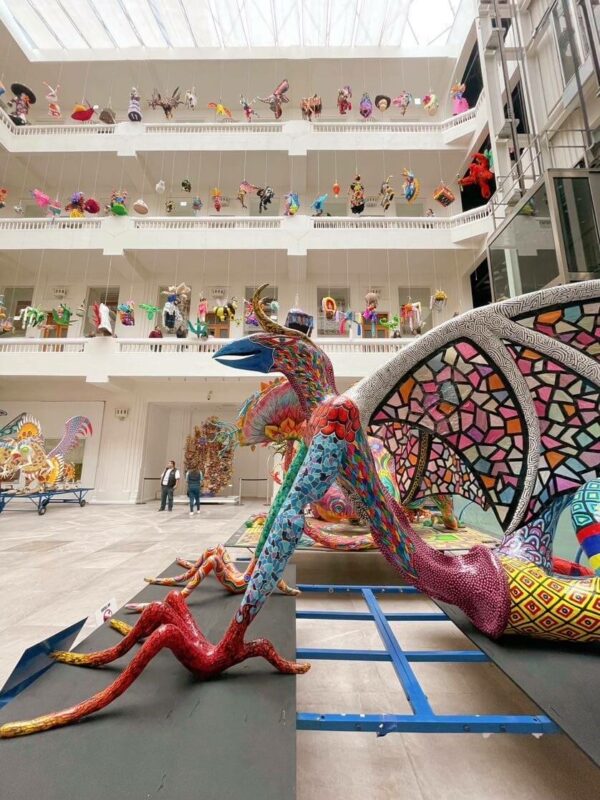
Visiting the Popular Art Museum is another of the best things to do in Centro Historico. It’s unlike most galleries I’ve been to because it doesn’t display historic, traditional art but it also doesn’t focus on pretentious modern art.
Instead, it’s all about Mexican folk art. From the second you enter, you’re surrounded by vibrant alejibres: weird and wonderful creatures dreamed up by the artists. These are the highlight for me but the museum also holds over 3,000 other items from pottery to textiles, glasswork, and more. It’s a fantastic place to learn about pre-Hispanic cultures.
An hour to look around is enough.
If you’re visiting around the Day of the Dead, don’t miss La Noche de los Alebrijes (Night of the Alebrijes) event at the Museo de Arte Popular.
Entry price: 60 pesos (free on Sundays).
Opening times: 10am-6pm, Tuesday-Sunday (closed Mon).
National Art Museum (MUNAL)
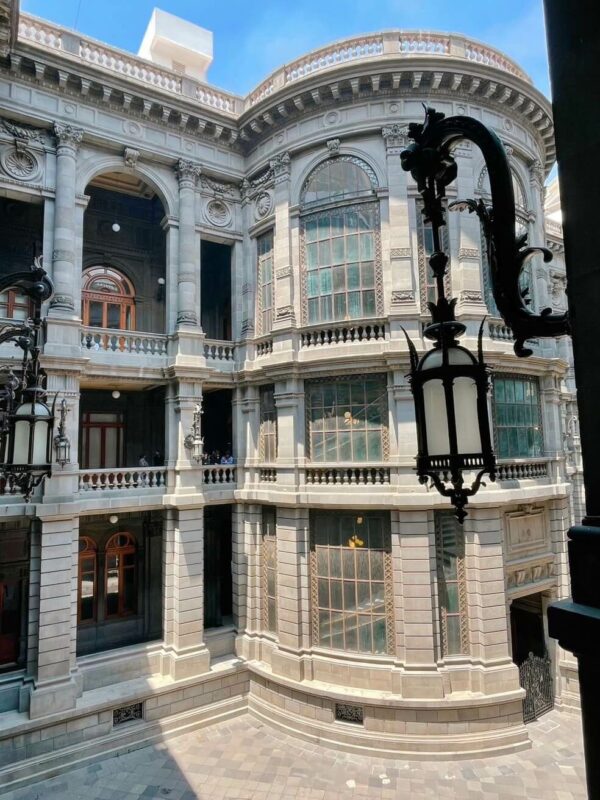
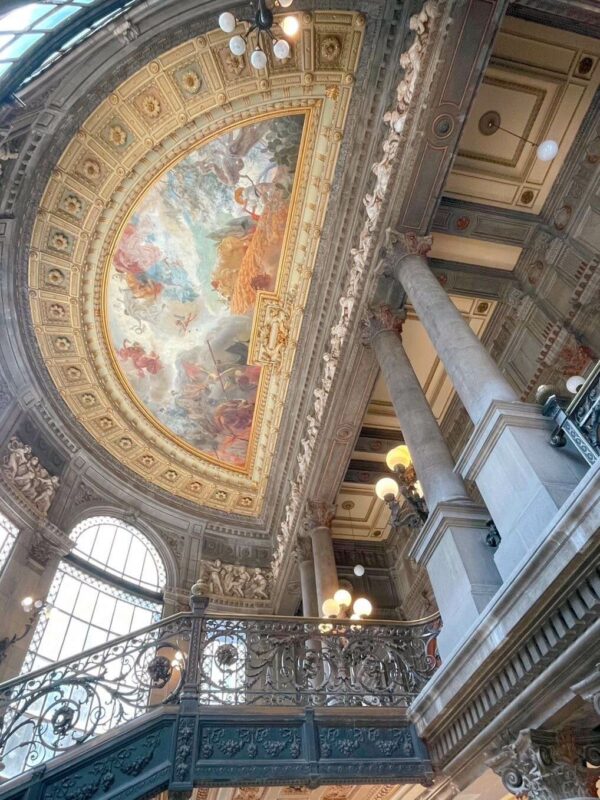
The National Art Museum (MUNAL) is one of the most famous galleries in the Historic Center known for its classic Mexican art collection dating from the mid-16th to mid-20th centuries. It’s split into three sections: the colonial period, the first century after independence, and post-Revolution art.
The colorful volcanos of the Valle de Mexico art by José María Velasco was easily my highlight of MUNAL.
The building itself is stunning, built in 1900 to resemble an Italian Renaissance palace. Walking up the sweeping staircase to the galleries on the upper levels is a grand and memorable experience!
Foreign temporary exhibits (such as Monet’s Water Lilies in 2023) visit occasionally so check what’s on before your visit. There are free English guided tours at 12pm and 2pm.
Don’t miss the gift shop selling affordable prints (in different sizes) of the art in the galleries, alongside coasters and fridge magnets.
Entry price: 85 pesos and 5 for a camera permit.
Opening times: 9am-5.30pm, Tuesday-Sunday (closed Mon).
Franz Mayer Museum
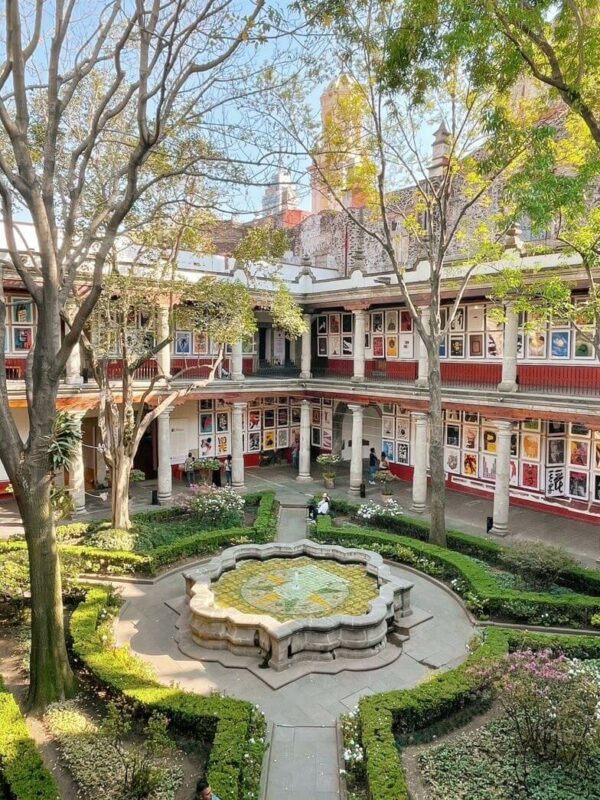
This historic residence beside Alameda Park has been everything from a hospital to a monastery, but now it’s Latin America’s largest collection of visual arts. Away from the noise of the city, the Franz Mayer Museum has a lovely courtyard and cafe.
Named after Franz Mayer, the German philanthropist who set it up as a cultural house, it’s packed with art, statues, textiles, and books from around the world.
Since I’ve lived in the city, it’s hosted some incredible temporary exhibits including one on Steve McCurry, one of my favorite travel photographers.
Price: 70 pesos or free on Tuesdays (temporary exhibits have varying costs).
Opening times: 10am-5pm, Tuesday-Sunday (closed Mon).
Museo Archivo de la Fotografía
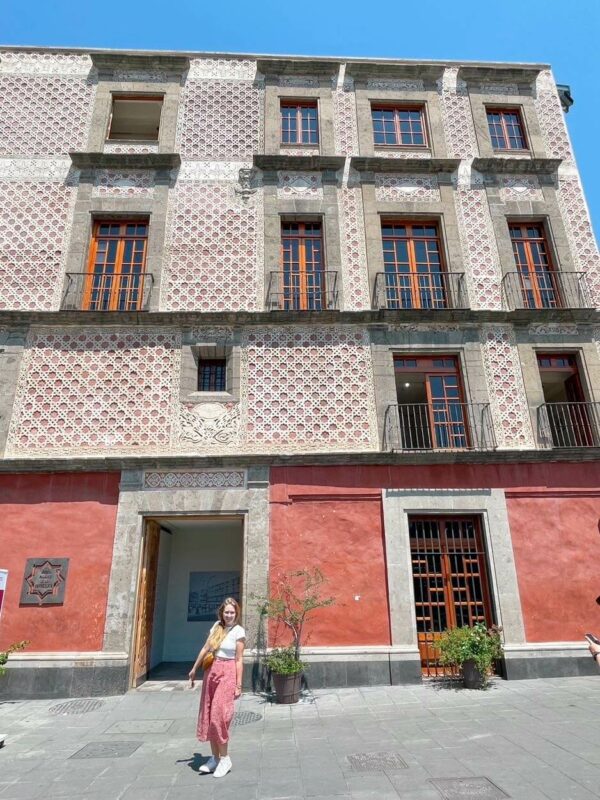
Beside Tenochtitlan, the Museo Archivo de la Fotografía is a small, free gallery with ever-changing exhibits. I recently caught a fascinating one about the lives of women in Mexico covering themes from aging to body image.
Opening times: 10am-5pm (closed Mon).
Where to see Diego Rivera murals in the Historic Center of Mexico City
It’s hard to talk about art in Mexico City without mentioning Diego Rivera, the famous husband of Frida Kahlo. Although I don’t like anything I hear about him as a person, his enormous detailed murals are simply incredible. I think I’ve seen every one in the city now, so you can tell I’m a fan!
There are several places to see his murals including Palacio de Bellas Artes already mentioned above. Other spots are…
The National Palace (Palacio Nacional)
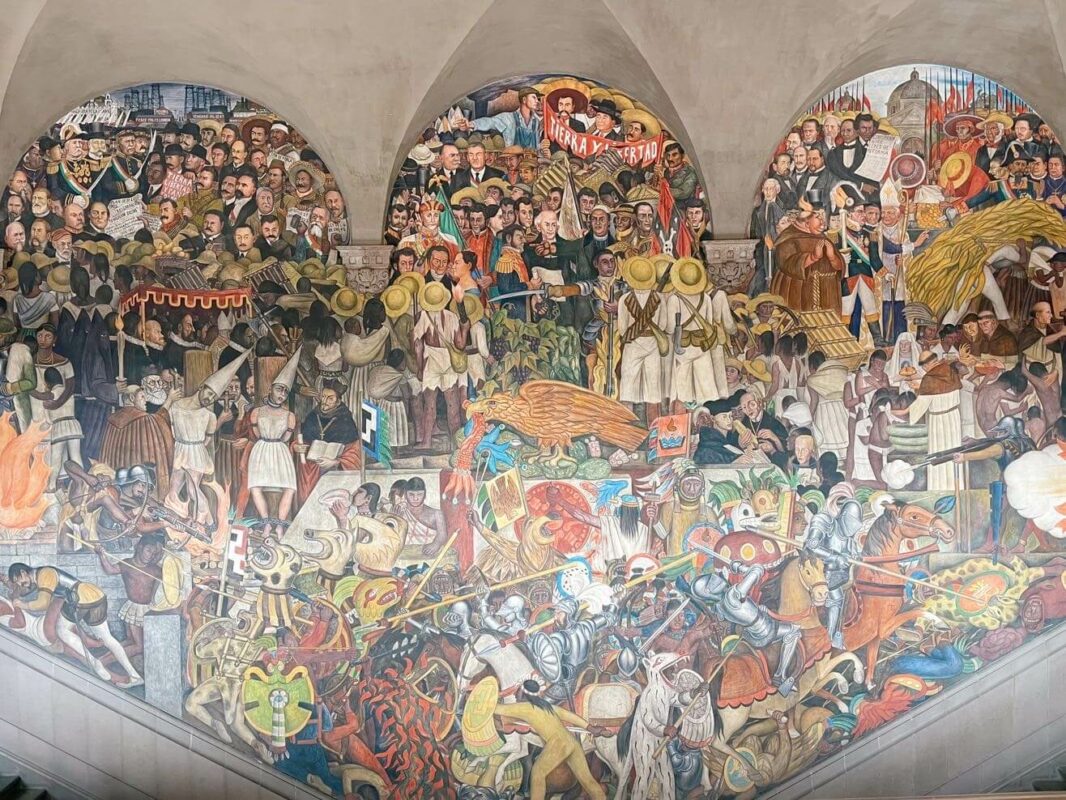
Aside from the place I’m about to mention next, this is the best place in the Centro Historico of Mexico City to see Diego murals. It’s also one of the hardest to visit because you can only go as part of a guided tour and tickets are quickly snapped up (perhaps because Lonely Planet mentioned it as a place to visit in 2024).
Still, it’s worth it when you get inside. The National Palace (the official residence of the President) is a stunning building with a cactus garden and the jaw-droppingly ornate Supreme Court of Justice inside.
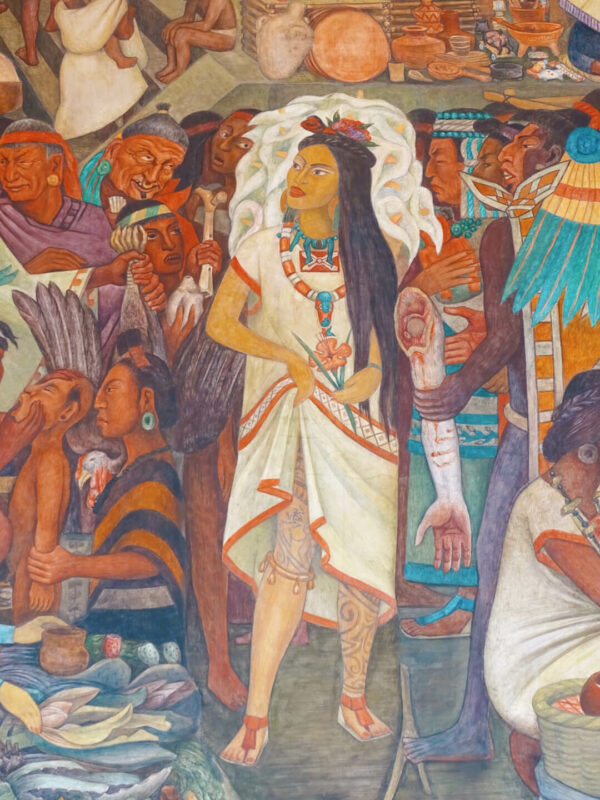
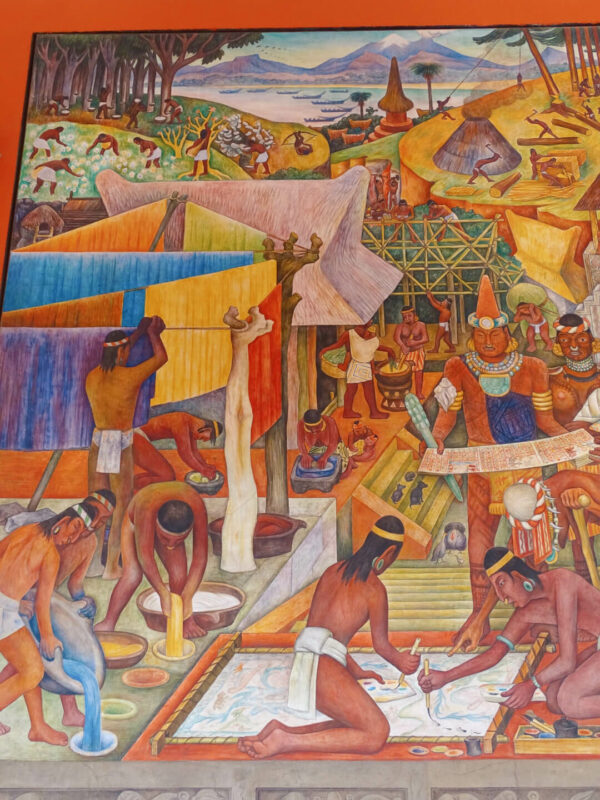
But the highlight is the many Diego murals circling the corridors of the upper level. Since you visit with a guide, you learn about the meanings of the murals and gain a fascinating insight into the history of Mexico (up to the 1930s). The tour is free and last 1 hour.
How to visit: English tours depart daily at 10.30am from the office across the road from the Palace, so you should be there at 9.30am to line up. The first time I did this, I still didn’t get a place but I managed to get a ticket for the next day (not so convenient if you only have a day assigned to Mexico City’s Historic Center). Another option is to email them but sometimes it bounces back saying the inbox is full.
You need to bring your official ID and leave it with the guards to receive back when you exit.
Secretariat of Public Education
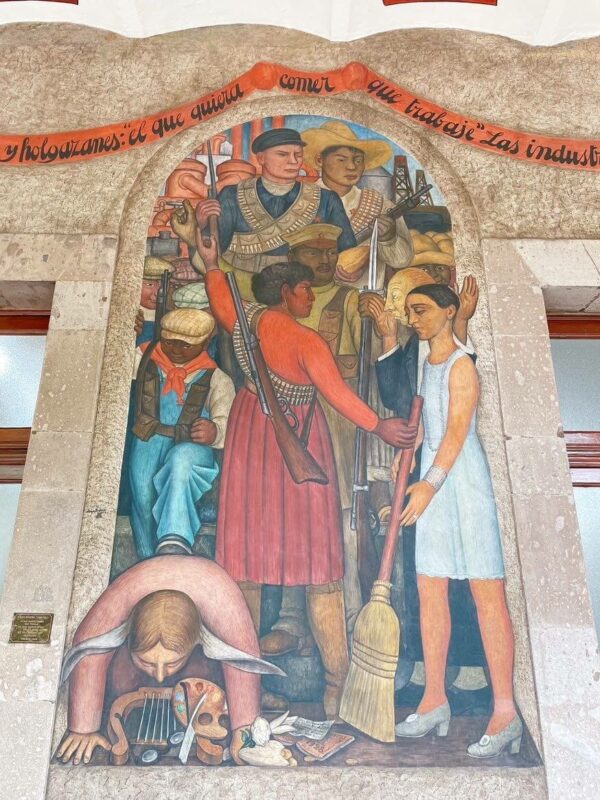
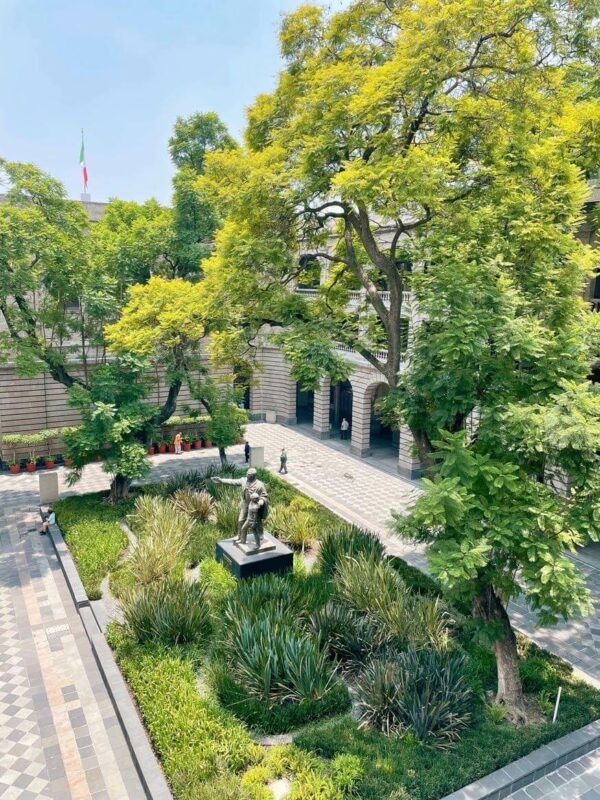
Another of the top things to do in the Historic Center is wander the grounds of this huge public building surrounded by Diego frescos under shady archways. There are even more murals than in the National Palace… I lost count but sources say 120!
The frescos were completed in the 1920s with the purpose of (in Diego’s words) showing ‘the very life of the people’. After his trip to the Soviet Union, he added communist themes to these paintings highlighting the working class. Frida and several other famous characters appear in the works.
There are signs in English and Spanish. I’d suggest dedicating an hour to the Secretaría de Educación Pública (Secretariat of Education). Apparently, there are more murals than can be seen as part of a guided tour but I’m unable to find out how to organize one.
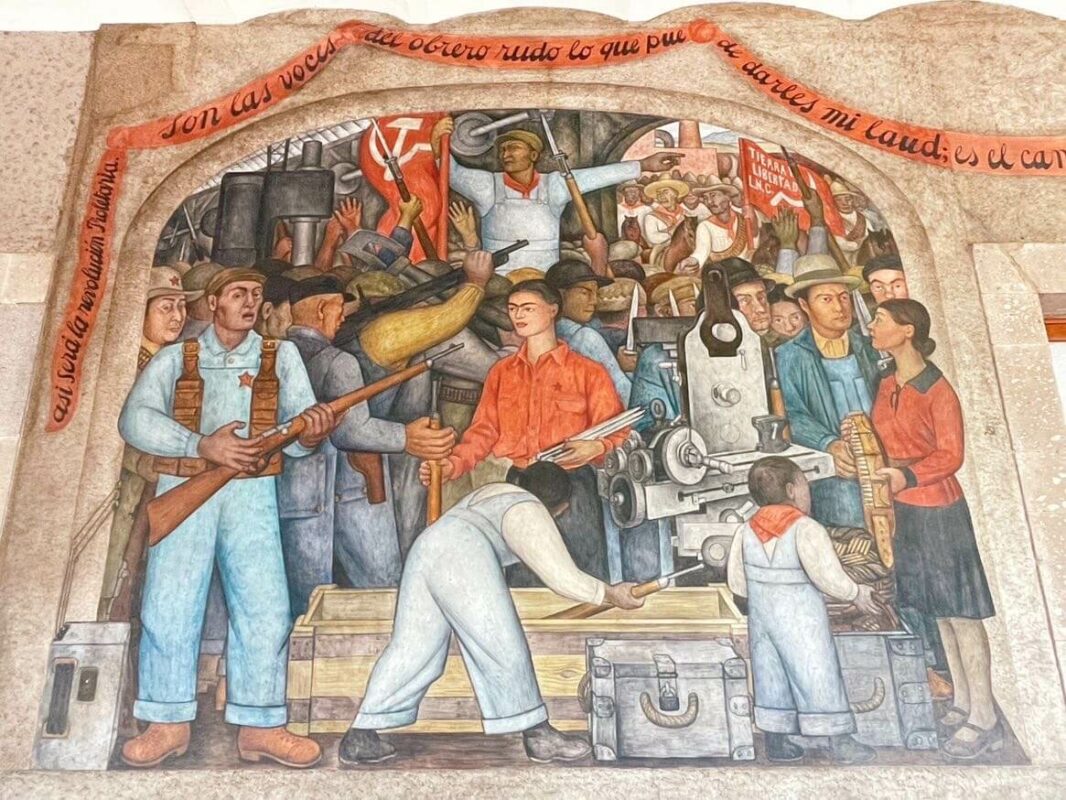
The Secretariat of Education is free to visit but you need to remember to bring an official ID. Find it on República de Brasil 31 across from Plaza de Santo Domingo.
Opening times: 8am-4pm, Monday-Friday (closed weekends).
Museo Mural Diego Rivera
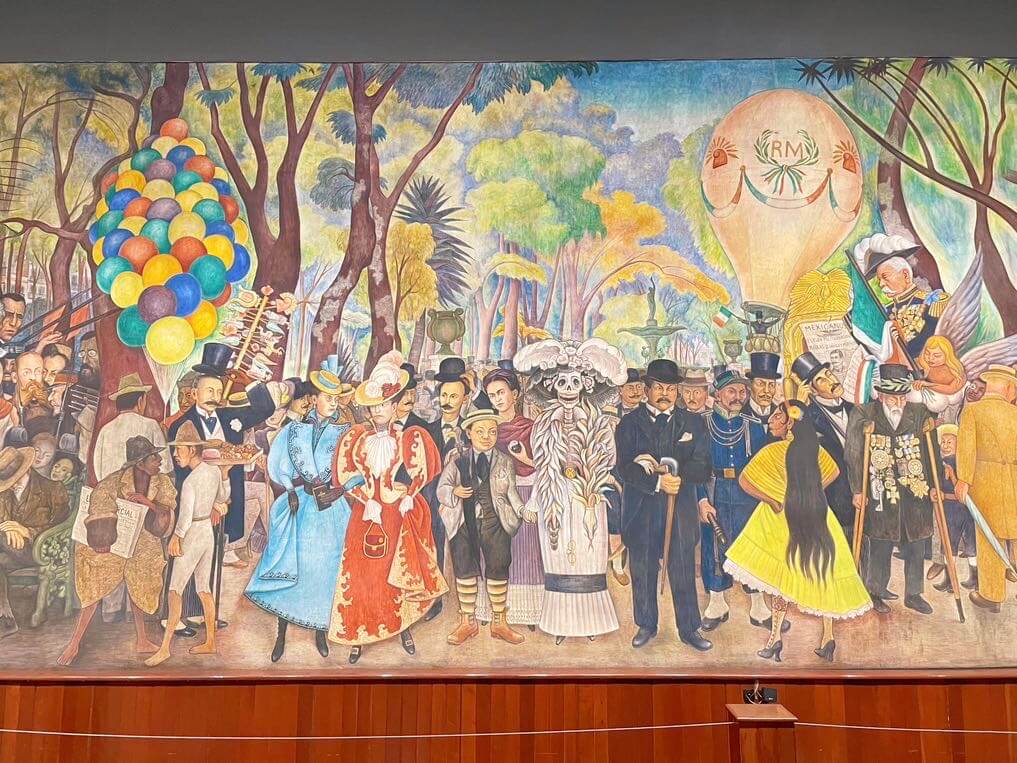
This is a small museum with just one painting inside… But it’s a big one! The Dream of a Sunday Afternoon in Alameda Central measures almost 16 meters in length.
If you’re in a rush while sightseeing in the Historic Center, Museo Mural Diego Rivera is a good place to visit because you don’t need much time there (well depending how long you spend trying to pick out themes and meanings from the painting).
If you’re really in a rush visiting downtown, you can kill two birds with one stone by going for lunch at nearby El Cardenal where there’s a replica inside the restaurant. The food is tasty and affordable.
Opening times: 10am-6pm, Tuesday-Sunday (closed Mon).
Price: 40 pesos or free Sundays.
Former College of San Ildefonso
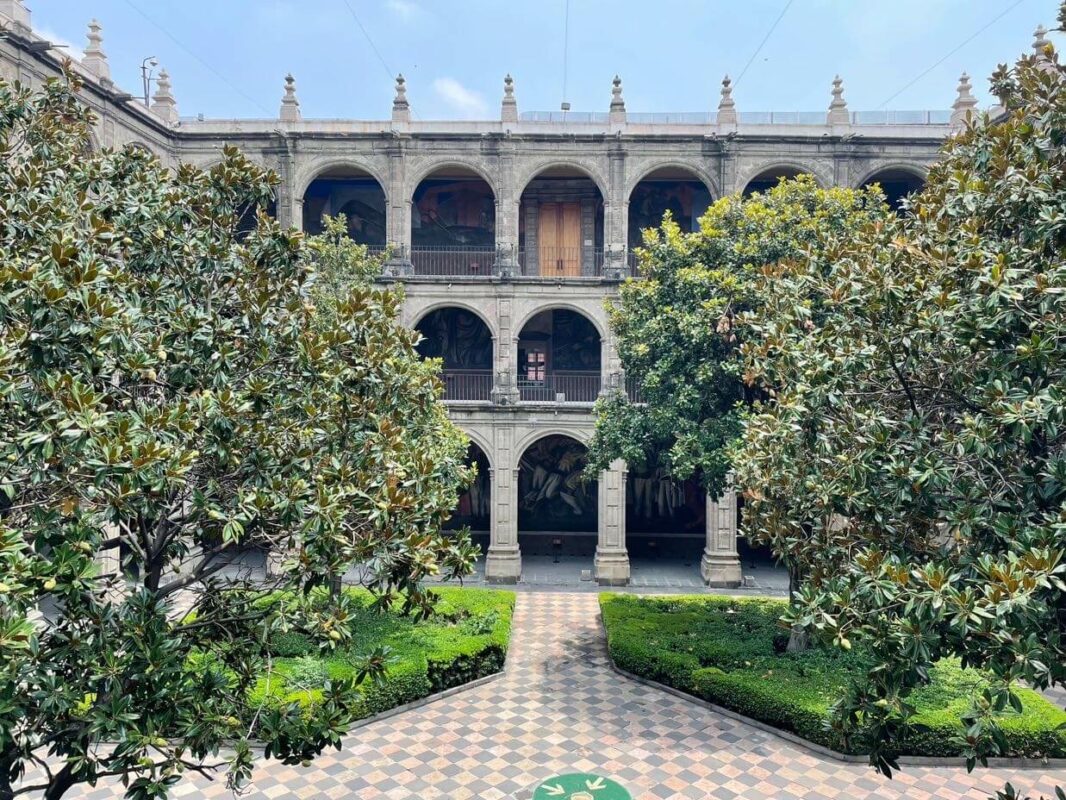
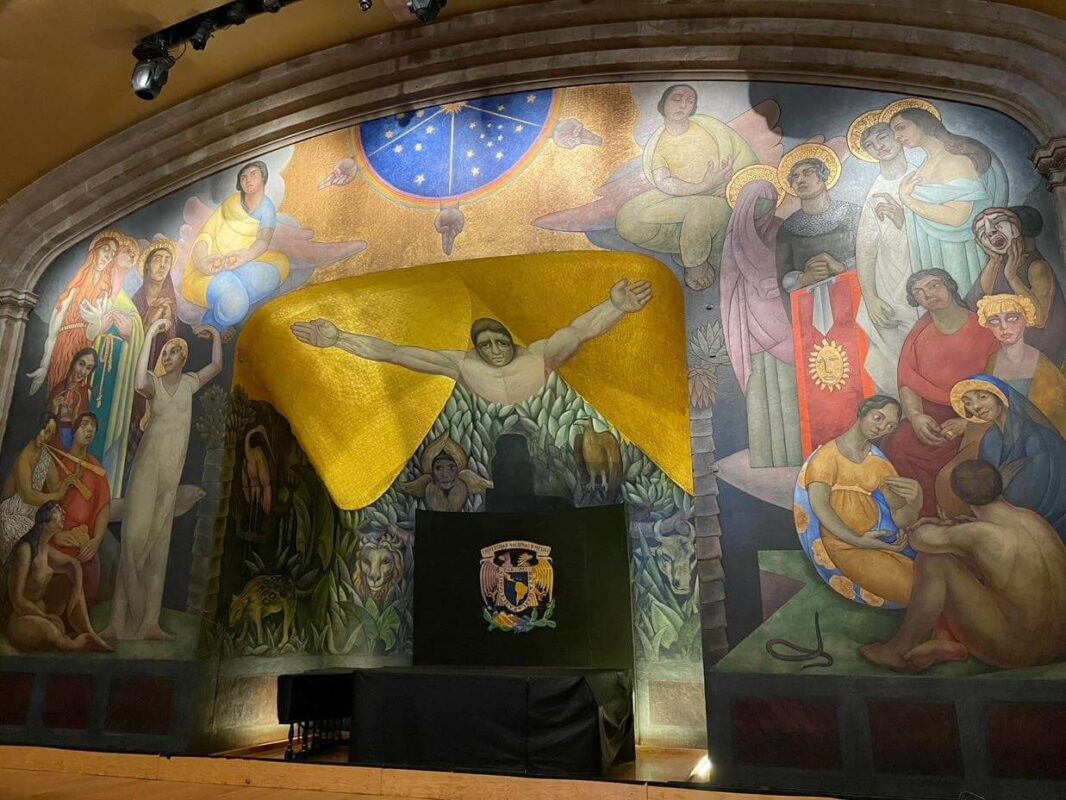
By the time you’ve visited the places above, you might be underwhelmed by the Former College of San Ildefonso. There’s nothing bad about it but there’s only one Diego mural and it’s not his typical style. Still, it’s a beautiful building with several rooms of art by José Clemente Orozco and Fernando Leal so it’s worth a visit if you have time.
The Diego mural can be found in the theater at the back. La Creation (1922) has a religious focus showing a man in a cross position.
Entry costs 25 pesos and I’d recommend an hour there.
Opening times: 11am-5.30pm, Tuesday-Sunday (closed Mondays).
Price: 25 pesos.
Foro Valparaiso
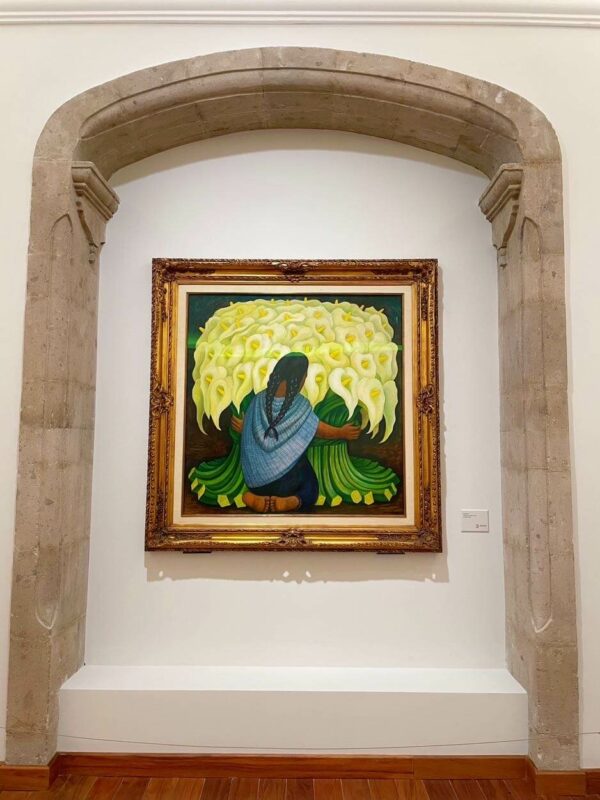
My friend and I visited Foro Valparaiso because we’d seen photos of beautiful tiled domes on the roof terrace. Sadly, this area is closed to the public aside from special occasions. However, we discovered that the building is a captivating free attraction in Centro with beautiful architecture and more than 150 artworks upstairs including Diego’s Flower Seller painting (1942).
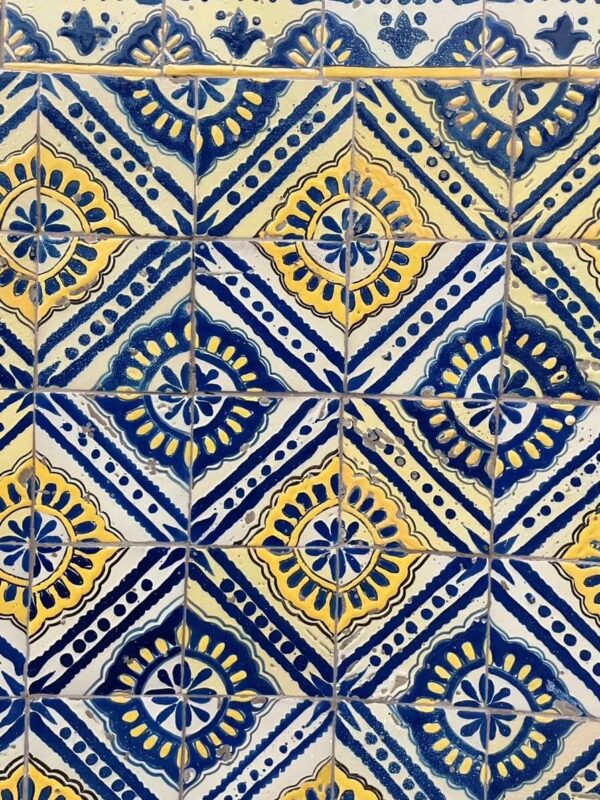
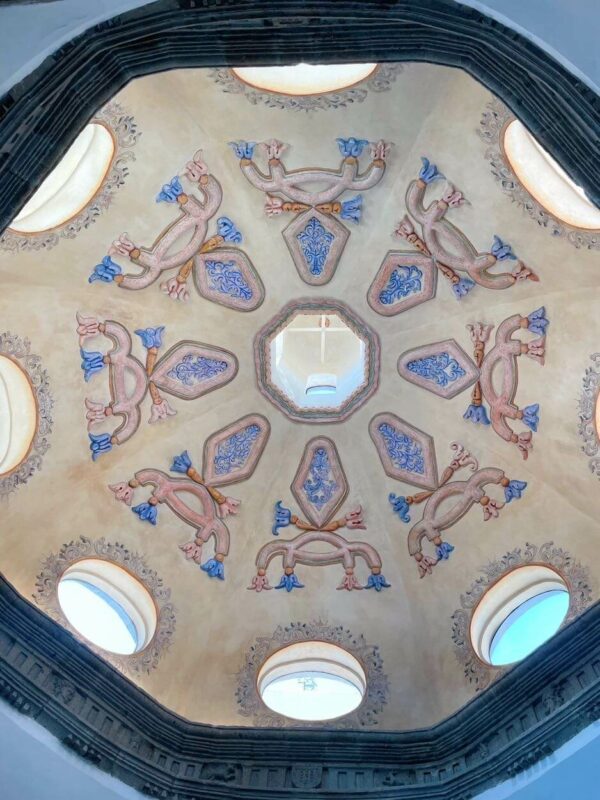
Don’t miss the free museum downstairs!
On entry, they give you a bracelet that you scan to make interactive displays operate. There’s one room about entrepreneurship and another with mind-stimulating games. Quite the contrast to the centuries-old art upstairs! If you’re visiting Foro Valparaiso, pop in for a few minutes. It’s all free!
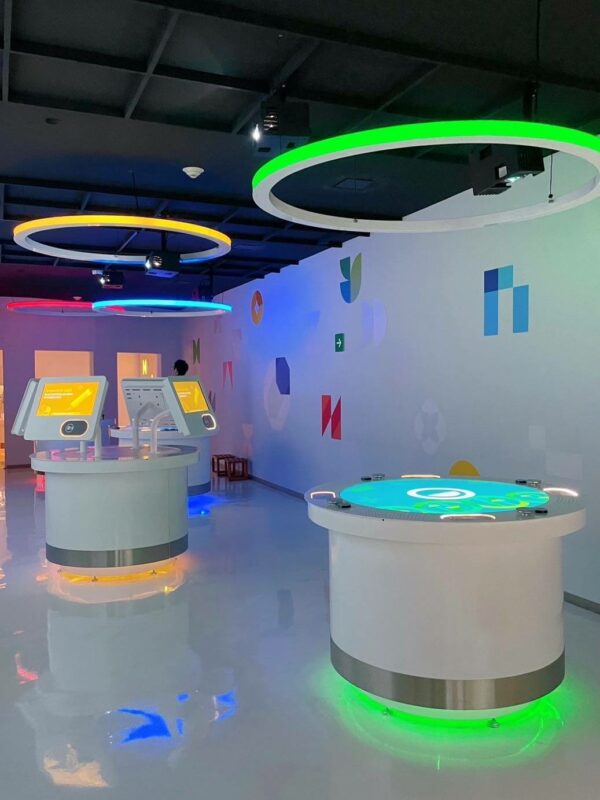
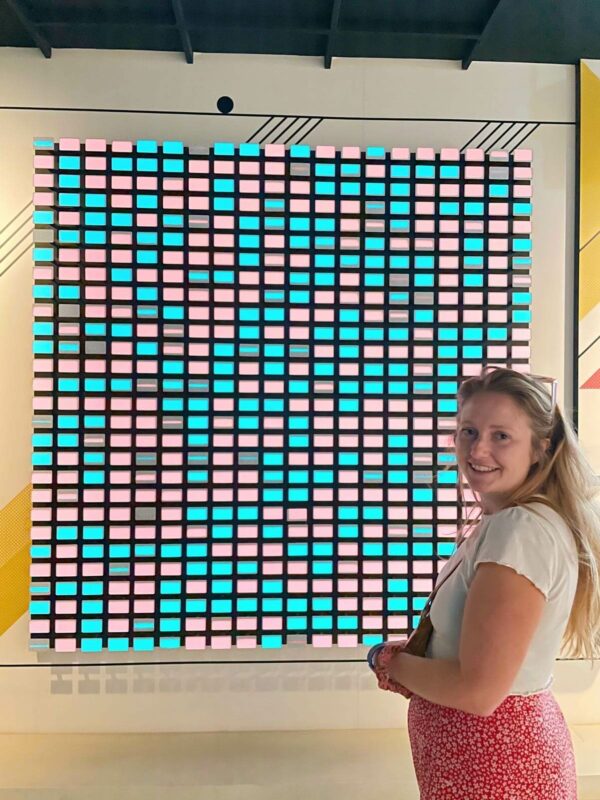
Hidden gems in Centro Historico
If you finish with the main attractions, pay a visit to…
Biblioteca Miguel Lerdo de Tejada
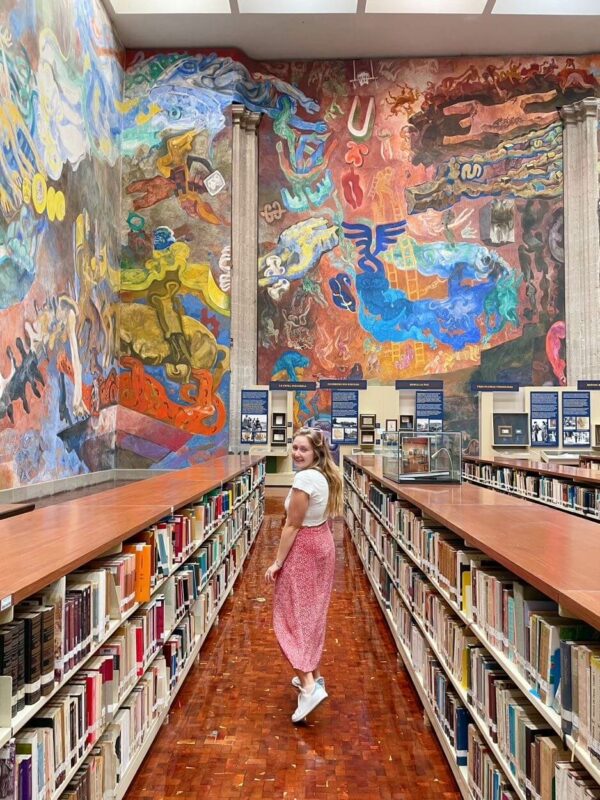
Inside an old colonial church that looks like any other lies one of the best hidden gems in Mexico City: a library covered in colorful murals stretching from floor to ceiling!
Biblioteca Miguel Lerdo de Tejada boats 21,000 feet of funky murals by Mexican-Russian artist, Vlady Rusakov, showing scenes from the Mexican Revolution. An exhibit at the front displays the timeline of this key event in Mexican history.
Tourists are welcome but just note that it’s a working library with people reading and studying so don’t be too loud!
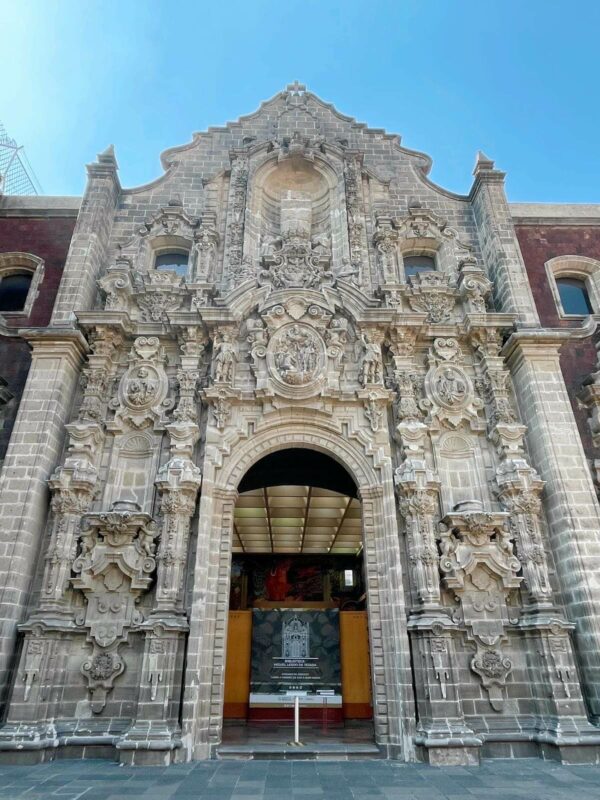
Find it in the south of Centro near Tenochtitlan ruins. Entry is free but you need to show an official ID (or photo of one) and leave your bag with security.
Farmacia Paris
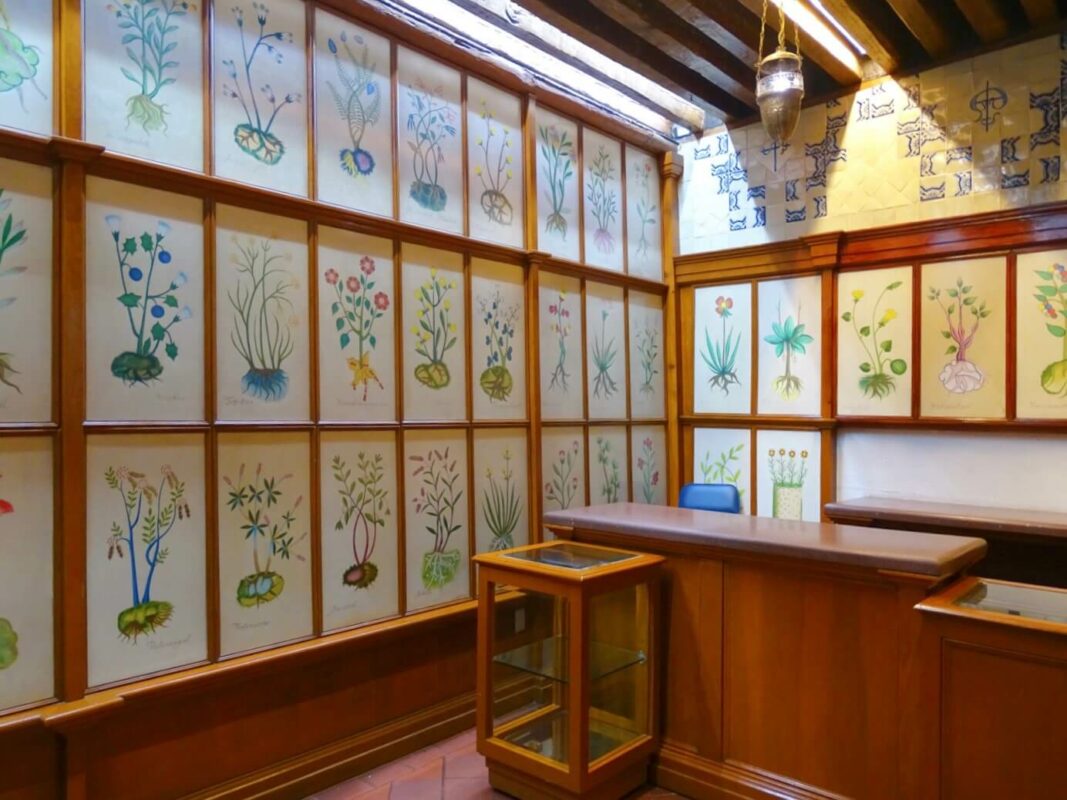
When my friend suggested we visit a pharmacy, I was underwhelmed. Really, why?
It turns out Farmacia Paris is a historical gem not to mention a ‘homeopatica’ with hand-illustrated drawings on the wall showing the herbs for purchase. It looks like something out of Harry Potter!
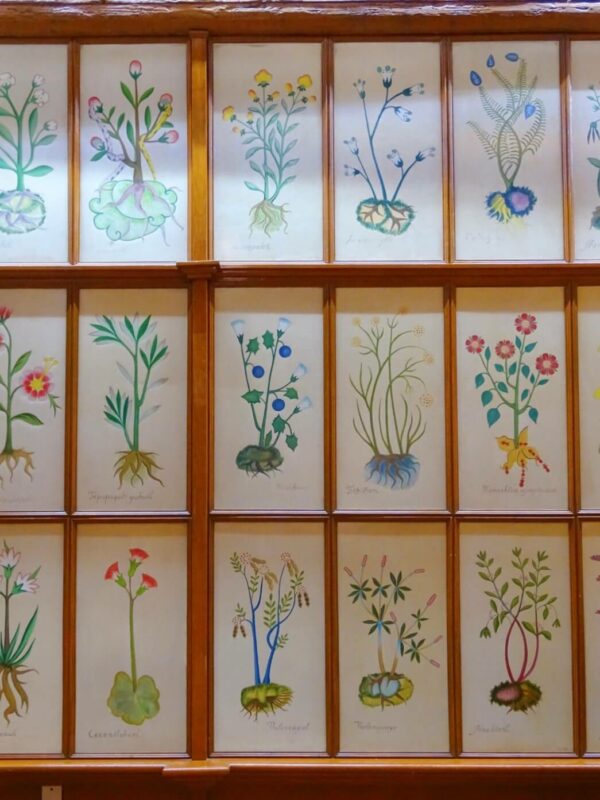
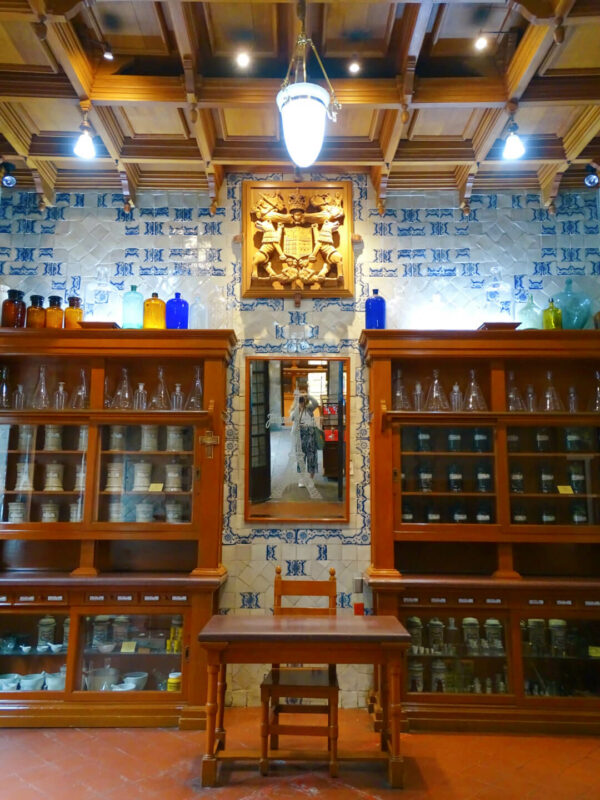
The historic store pictured above is on Republica El Salvador. Just around the corner on Calle de 5 Febrero is a larger (more modern) store selling a huge range of natural body products and essential oils. Everything is cheap.
Cereria La Purisima (candle shops)
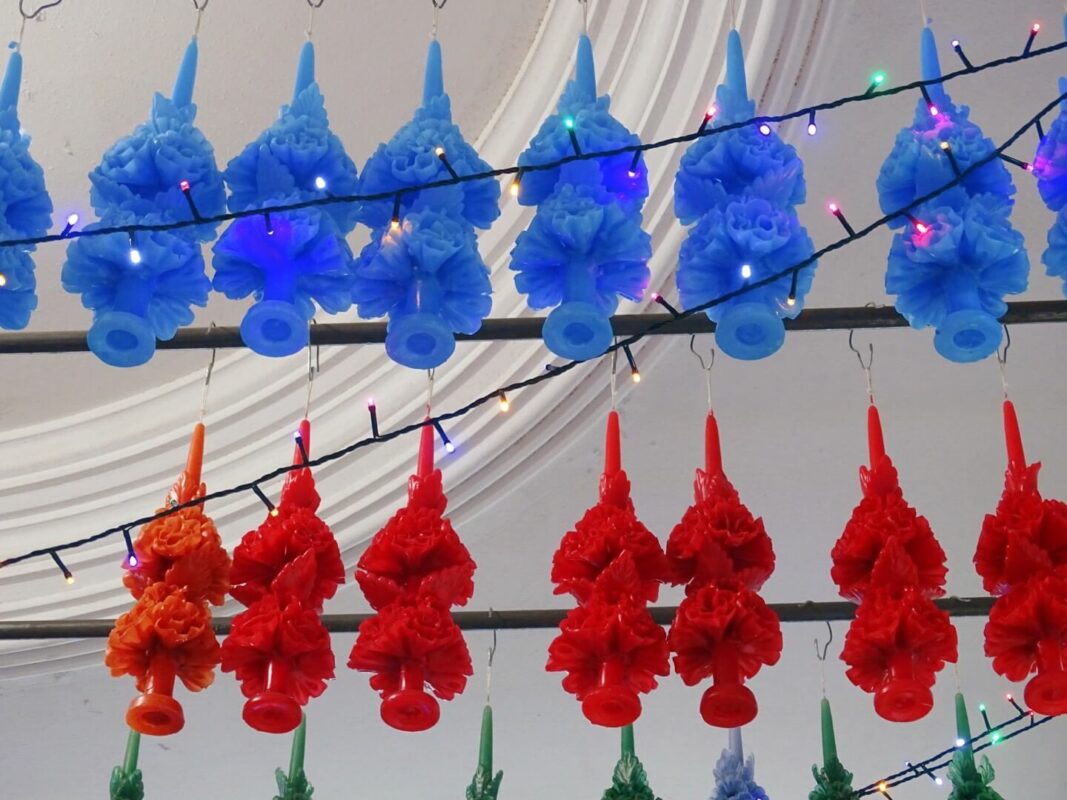
I’m obsessed with these local stores selling gorgeous candles. From beeswax candles to huge table pieces, there are so many colors to choose from. And they’re cheap! In any Roma Norte boutique, they’d be four times the price.
There are two stores: one in the busy market streets and one on a quieter street beside Isabel la Catolica metro station.
Markets in Centro, CDMX
The capital is heaving with markets including one deemed the biggest in the world! From hipster markets in Roma Norte to gritty, urban markets that are best avoided for tourists, there’s no end. On a day out in Centro, here are the best ones to visit…
Mercado de San Juan
In some ways, this is a typical Mexican mercado with fresh fruit and butcher stands. But Mercado de San Juan has a twist: it’s an exotic market where you can try any type of insect imaginable!
If that doesn’t appeal, the exotic theme extends to fancy cheeses and hams, served as tapas or in tasty baguettes.
Note – it’s not for the faint of heart, there are some stuffed lion and tiger heads that shocked me!
La Ciudadela Market
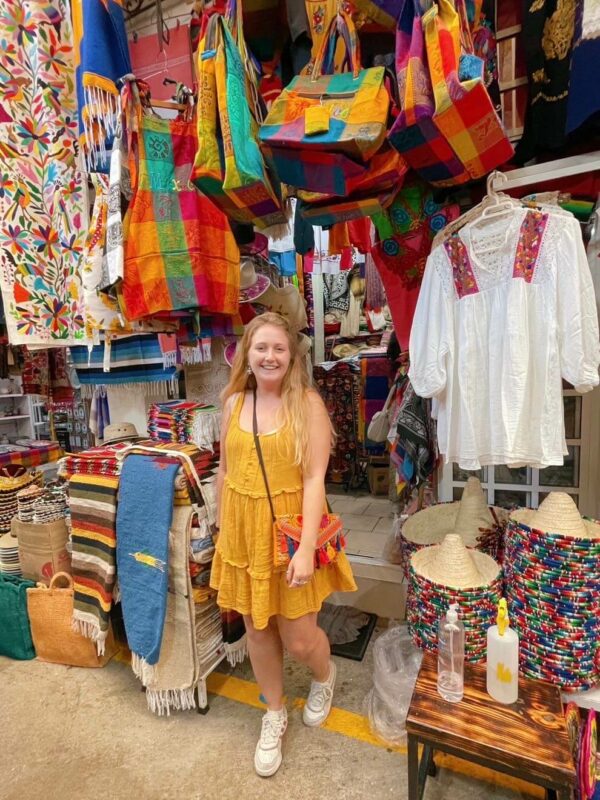
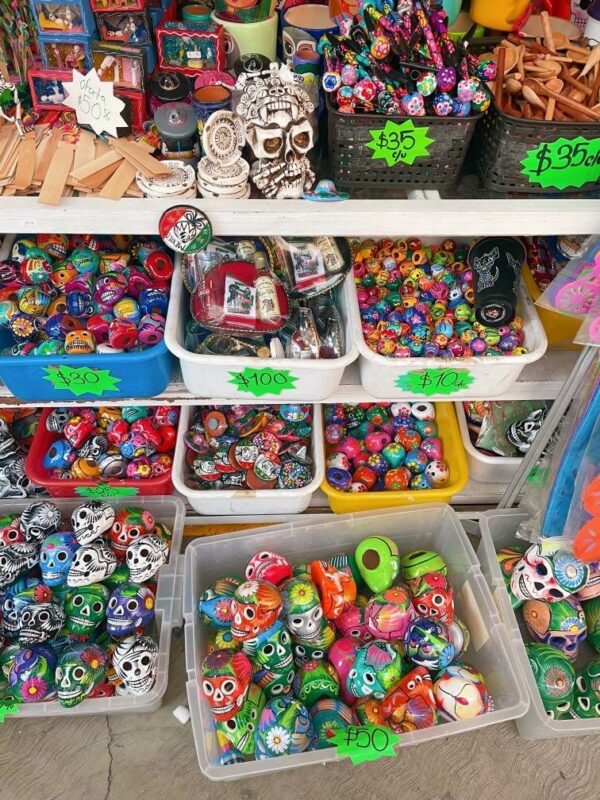
Technically in the Juarez neighborhood, La Ciudadela is only a short walk from Centro Histrorico and, in my opinion, it’s one of the best places to buy souvenirs in CDMX. From embroidered cushions and rugs to colorful skull ornaments and kitchenware including beautiful jugs and glasses, the list goes on and on.
The vendors don’t budge much on prices but if you purchase a few things, definitely try to negotiate a good deal!
Where to eat in the Historic Center of CDMX
You’re going to get hungry after ticking off so many things to do in Centro and luckily there are countless places to eat. Let’s start with…
Historic restaurants in Centro
Here’s where to have a nice, sit-down meal in an atmospheric restaurant in the downtown of Mexico City…
El Cardenal (three locations)
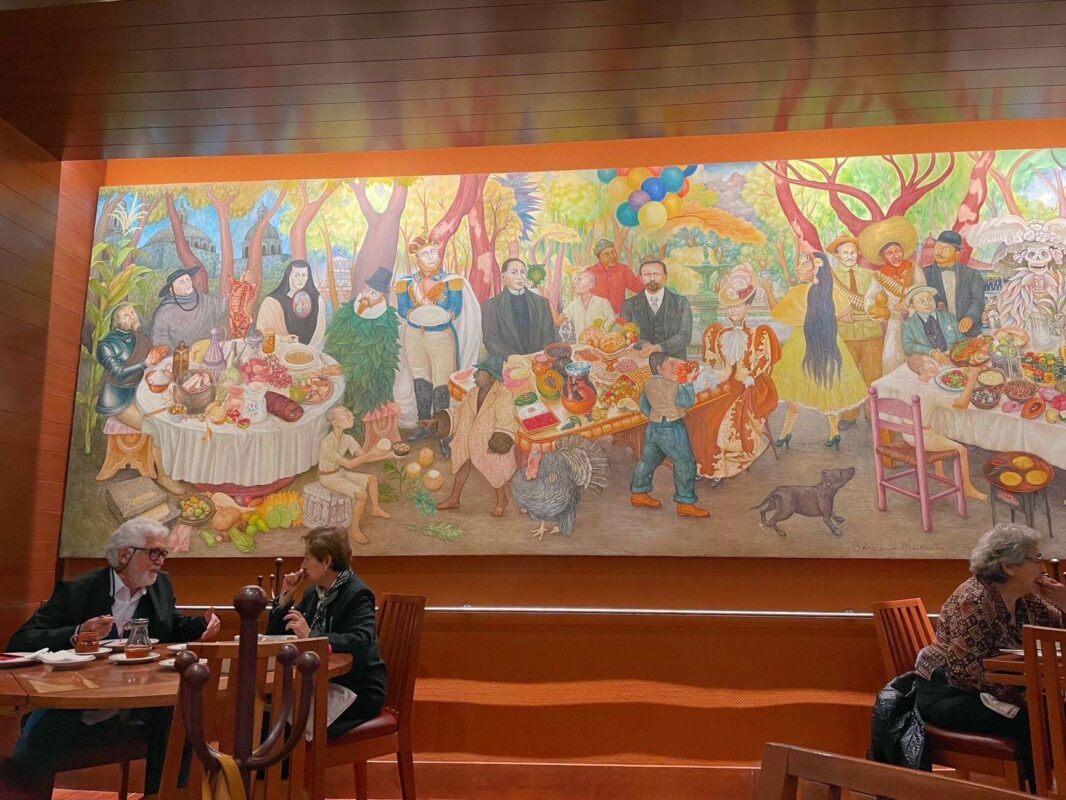
This restaurant with a replica of a Diego mural inside is surprisingly affordable since it’s in the lobby of a Hilton and the service is impeccable. Waiters pull out your chair for you and place napkins on your lap!
This is a great spot serving traditional Mexican dishes like enchiladas and egg dishes for the ultimate Mexico City breakfast or lunch.
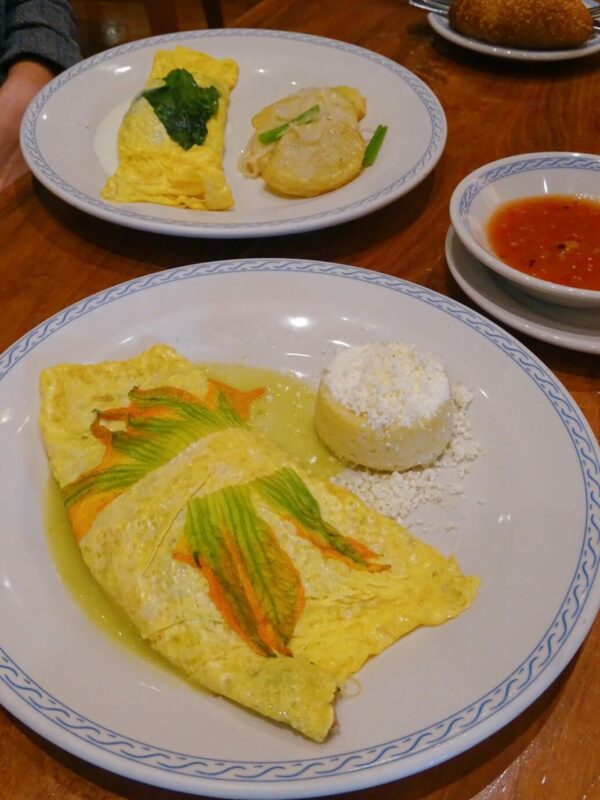
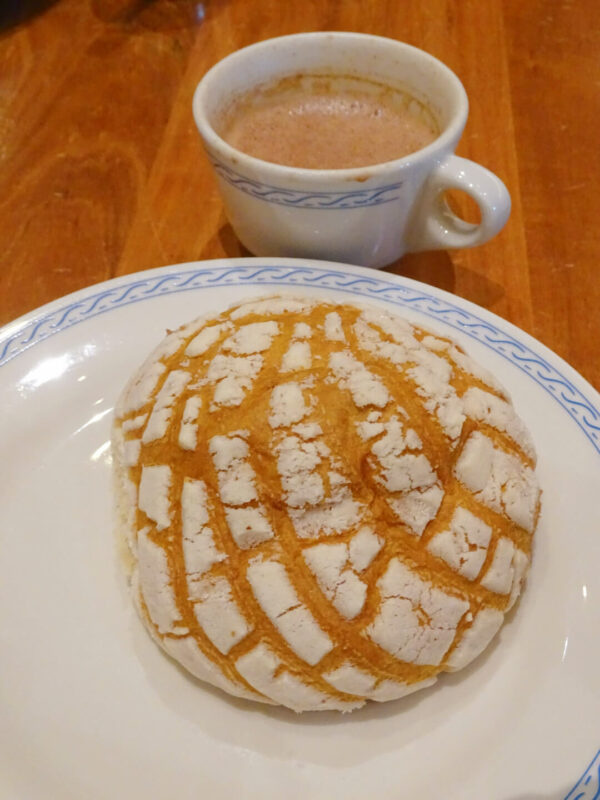
The flor de calabaza omelet was the best omlet I’ve ever had (I’ve been telling everyone about it since), and the hot chocolate and freshly baked conches are delicious, too.
There are three El Cardenal restaurants in Centro but the one with the Diego mural is near Alameda Central.
Cafe de Tacuba
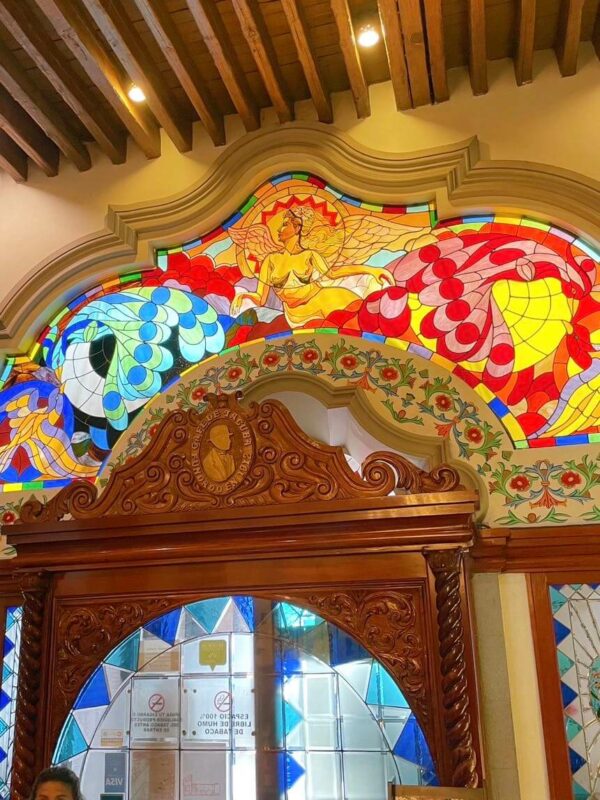
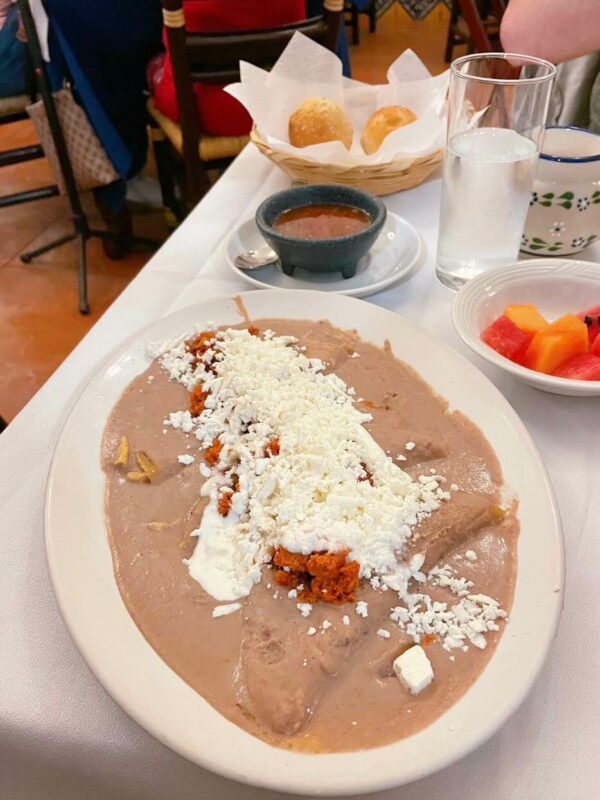
Another popular restaurant in Mexico City’s Historic Center is Cafe de Tacuba open since 1912. Like at El Cardenal, the staff dress in historic uniforms and the decor is decadent with stained glass and beautiful murals.
The food is tasty and for 200-300 pesos, you’ll get a hearty dish with a platter of fruit and a drink (coffee, hot chocolate, or atole).
Note – if you go to either of the above restaurants on a weekend or past 10am, you’ll have to wait in line. It’s worth it but I recommend going early on a weekday if possible.
Cafe Jekemir
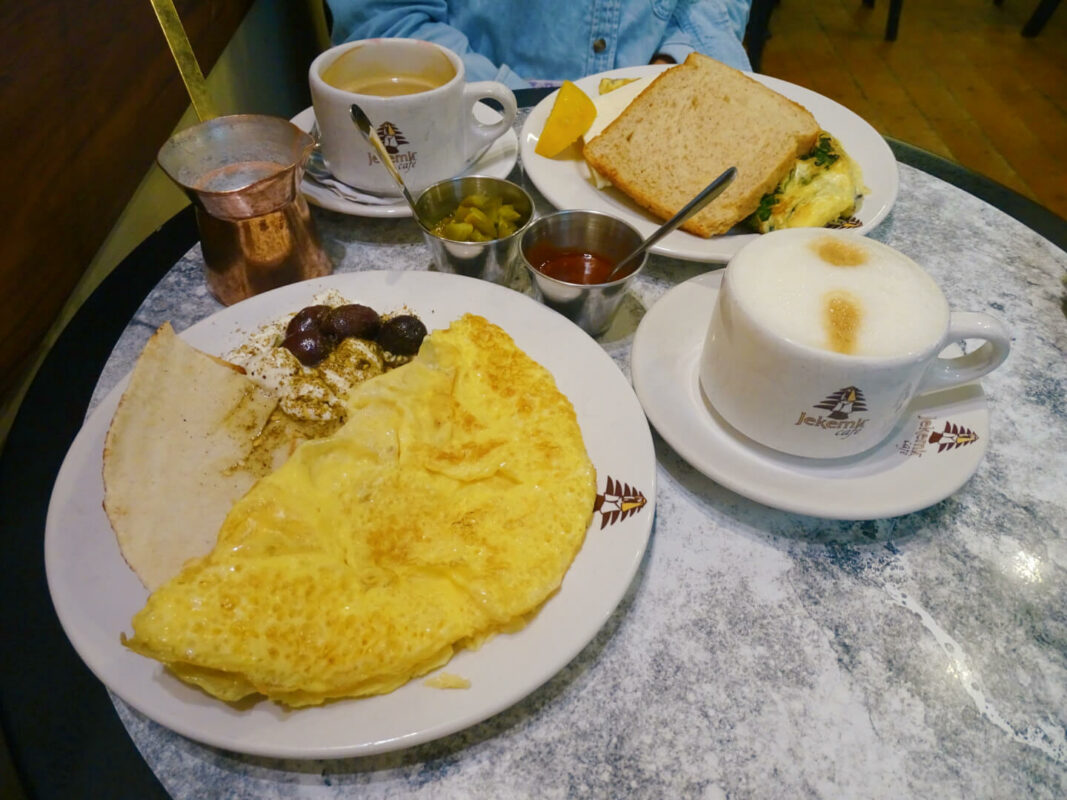
For a more relaxed breakfast or lunch without needing to stand in line, this old-school cafeteria on Regina (a pleasant pedestrianized street away from the hustle and bustle) is a great option.
Like many historic establishments in Centro, Cafe Jekemir has a Lebanese theme hailing back to the early 20th century when immigrants enriched the Mexican culinary scene with delicacies like tacos al pastor. I enjoyed a hearty ‘omlet arabe’ with jocoque cheese, olives, and pita bread, along with a cappuccino, for just 130 pesos.
Cafe Regina
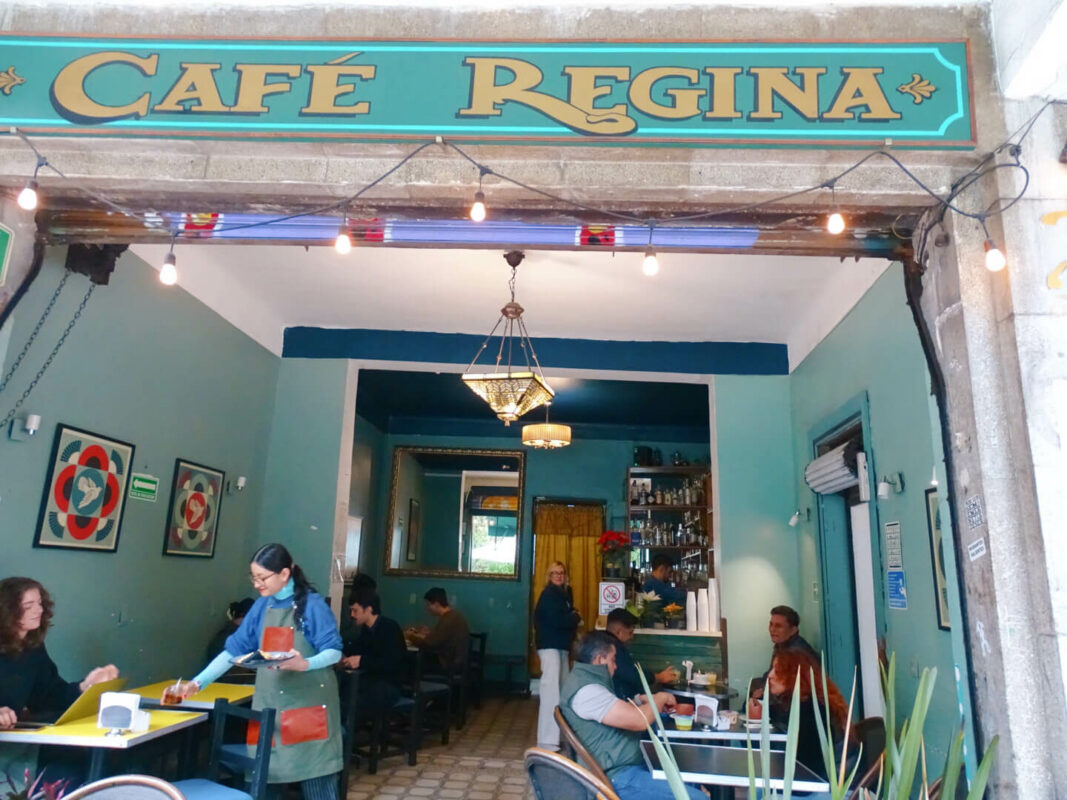
Just across from Cafe Jekemir is another classic cafe with decades of history. Cafe Regina is a lovely place with tiled floors and cosy, two-person tables. The homemade food is excellent, served with fresh salad and lots of veggies… Things not always easy to find in Mexican restaurants!
Note – the downtown isn’t the best place for vegans in CDMX but Vegamo is one good restaurant you can try. I also like VEGuerrero but it’s a little outside of the city center.
Best tacos in Centro, CDMX
The Historic Center of Mexico City has several famous taquerias. Here are some of the best…
Taqueria Los Coyocos
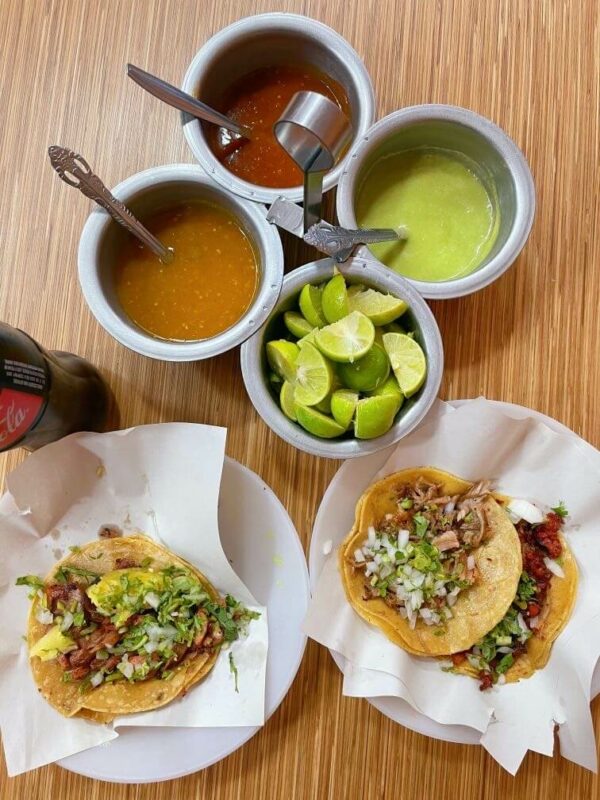
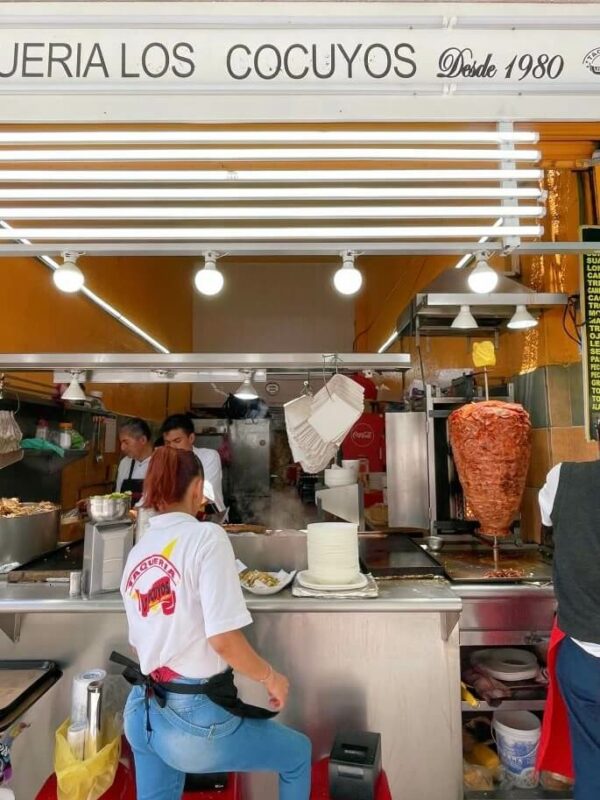
Taqueria Los Cocuyos is one of the most famous taco joints not just in Centro but the whole city, especially after it appeared on Netflix’s Taco Chronicles. The specialty is suadero (pork meat) but you can also try campechano, longaniza, chacete (beef cheeks)… and even tacos de ojo (eyeball tacos!)
Unless you request otherwise, your tacos come with cilantro and chopped onion, and the tacos al pastor come with pineapple. They’re delicious and just 20 pesos a piece!
Los Tacos de Canasta Los Especiales
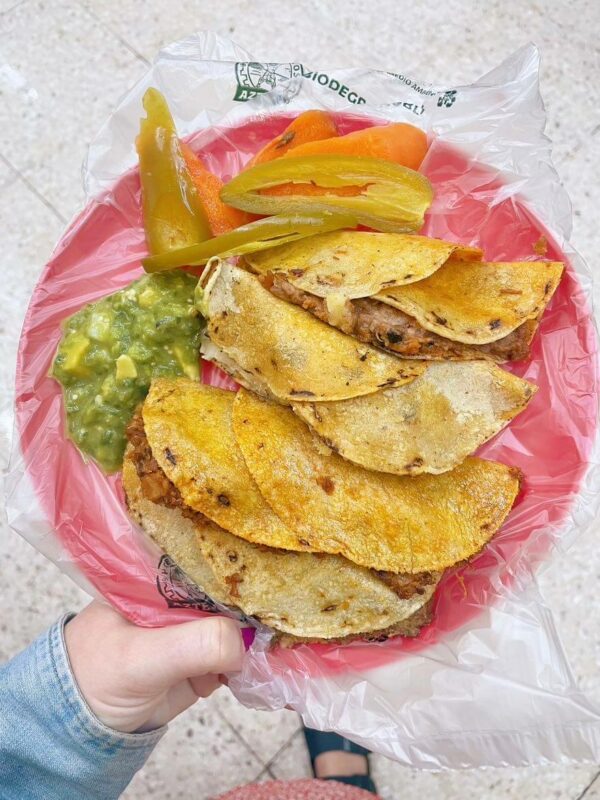
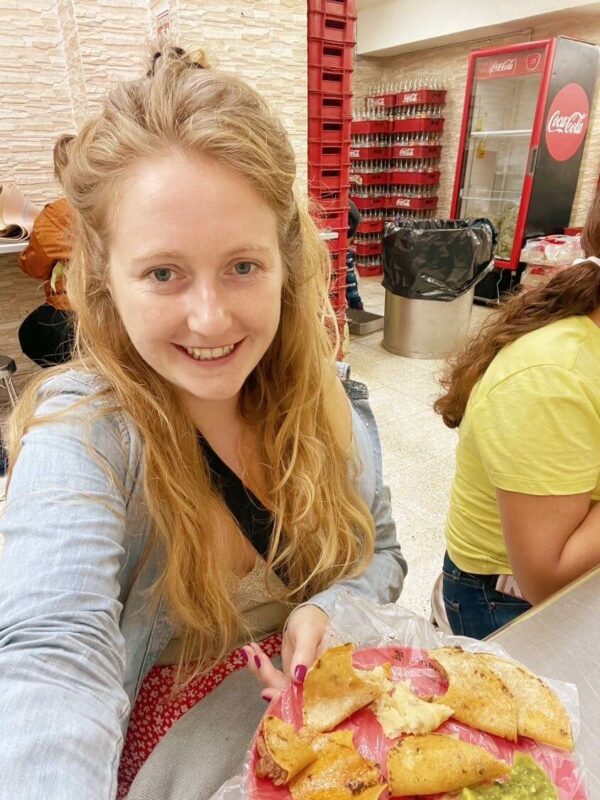
For something a bit different from your classic tacos al pastor, head bright and early (before the line starts building up) to Los Especiales specializing in tacos de canasta, in other words, basket tacos.
Choose from two types of chicharrones (pork rinds), frijoles (beans), and papas (potatoes). OR, don’t choose and get all four. At 8 pesos a taco, you may as well!
Ricos Tacos Toluca
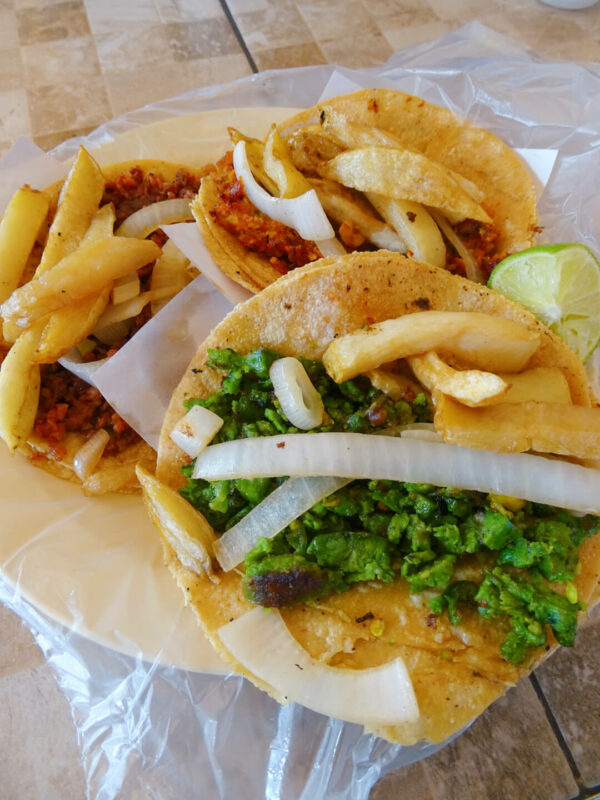
An unusual place for tacos in Centro Historico is Ricos Tacos Toluca… and rico they are! The specialty is chorizo tacos with four types: red, green, tamarind, and habanero chili.
As I wasn’t hungry enough for four tacos, I asked the guy which he considers best and he indicated all but the red so that’s what I went for. The green was my favorite; very fresh and flavorsome!
Better yet, they have what us Brits call ‘chips’ on top (and Americans call fries and Mexicans call papas). Other toppings include fried onions, their legendary guac, and a choice of spicy salsas.
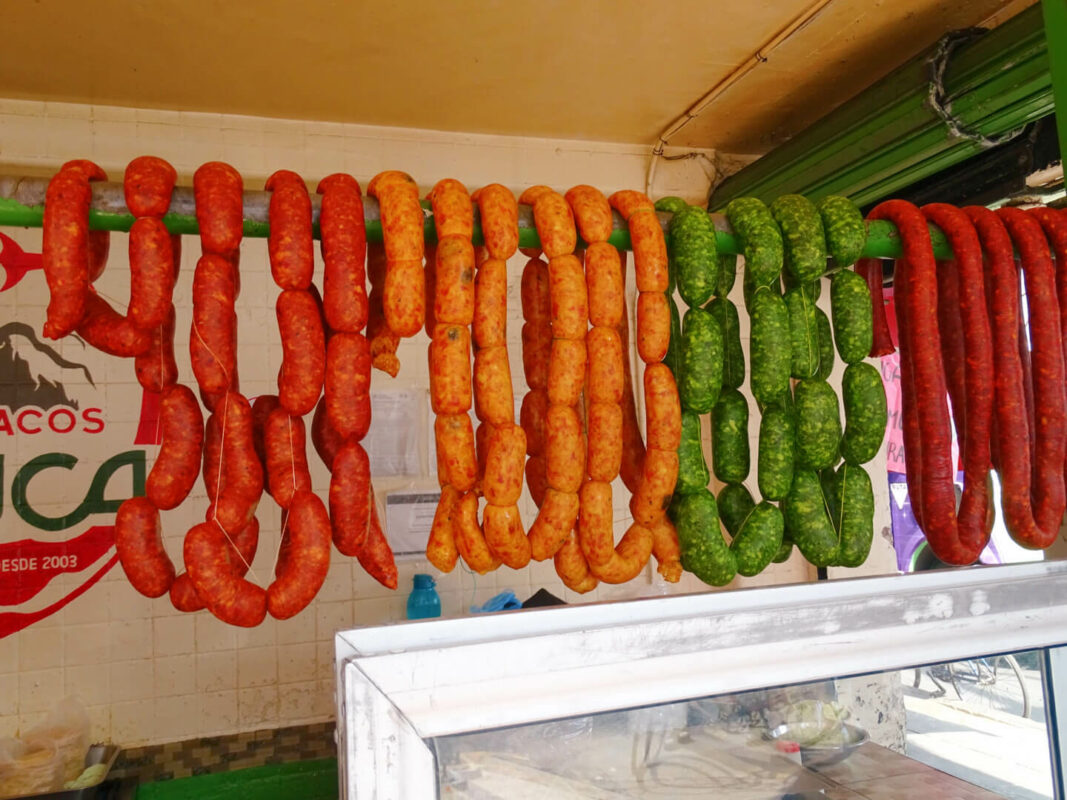
Chorizo tacos cost 27 pesos each. So, for three, I paid 81 pesos and I was full for hours!
Coffee & cafes in Centro Historico
Coffee fans, I got you!
Psst – I also have a guide to the 50+ best coffee shops in Mexico City that I think you should check out
Finca don Porfirio, Sears building
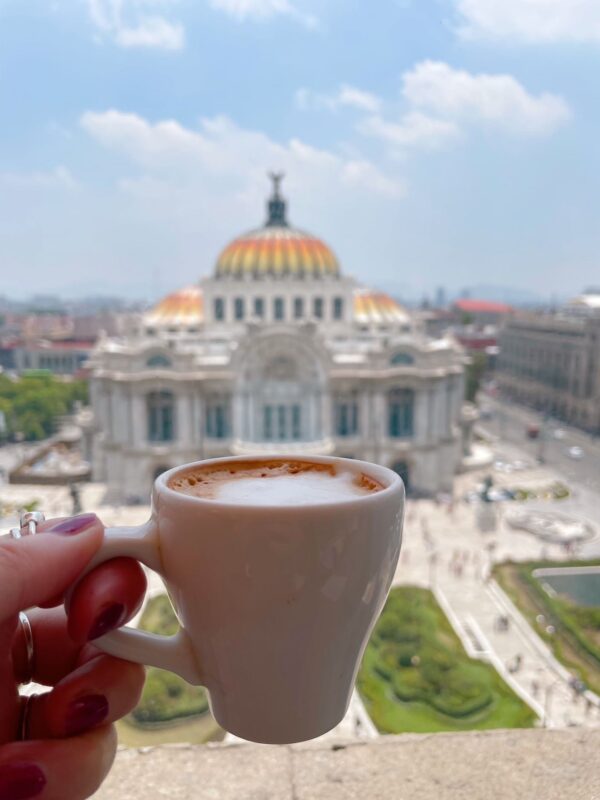
I promised you earlier I’d share the location of this place! To be honest, if you want a quick coffee or a good one, it’s not the best place in the Historic Center because the coffee is just ok and there’s usually a long wait.
But the views. The views!! Looking down over Bellas Artes, it’s easily the best vista in the city. Not bad for a 30 peso coffee!
To visit Finca don Porfirio, take the elevator to the 8th floor of the Sears Department building and get to the back of the line. It opens at 11am which is the best time to arrive.
Cafe El Chavalete
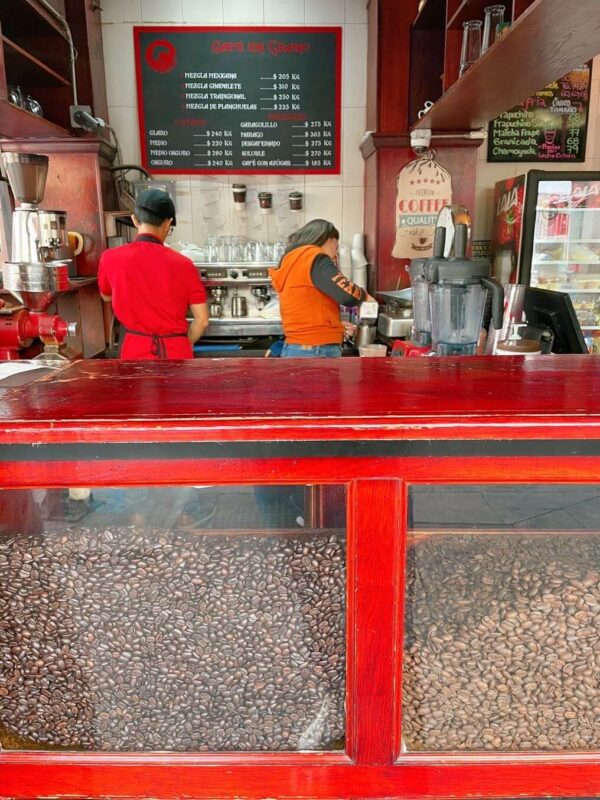
This is a classic coffee shop that’s been open for decades and has several branches in the city. The best is this one in Centro because there’s an upstairs area with a balcony where you can get some fresh air (although is the air in CDMX ever smog-free?).
Café El Cordobés o El Chavalete is in the south of the center near Mercado de San Juan.
Balam Coffee Roasters
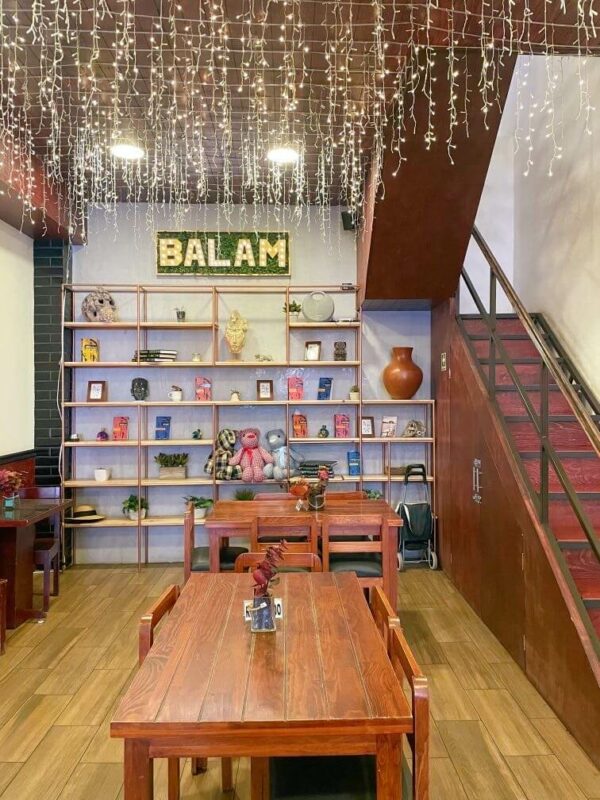
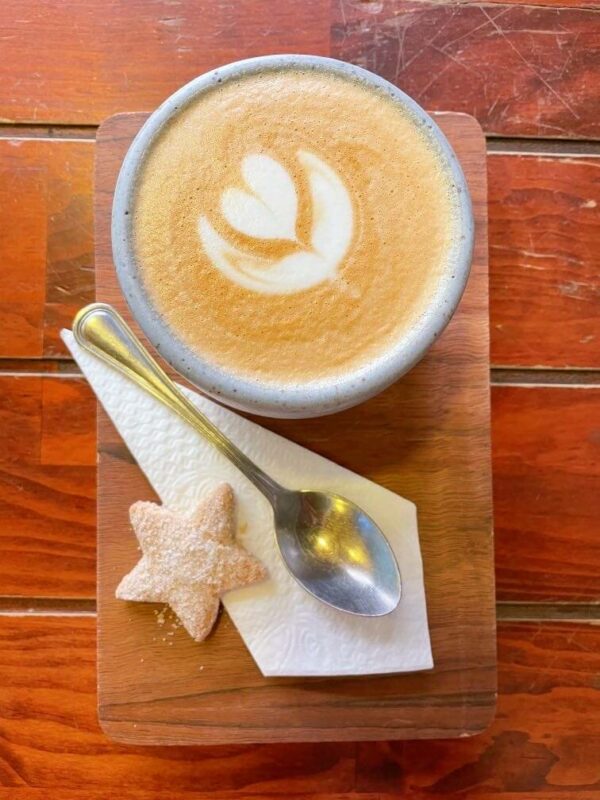
Balam serve specialty coffee and shockingly affordable breakfasts (from 50 pesos) right in the heart of the action. Grab one to fuel your sightseeing!
Casiopea Café
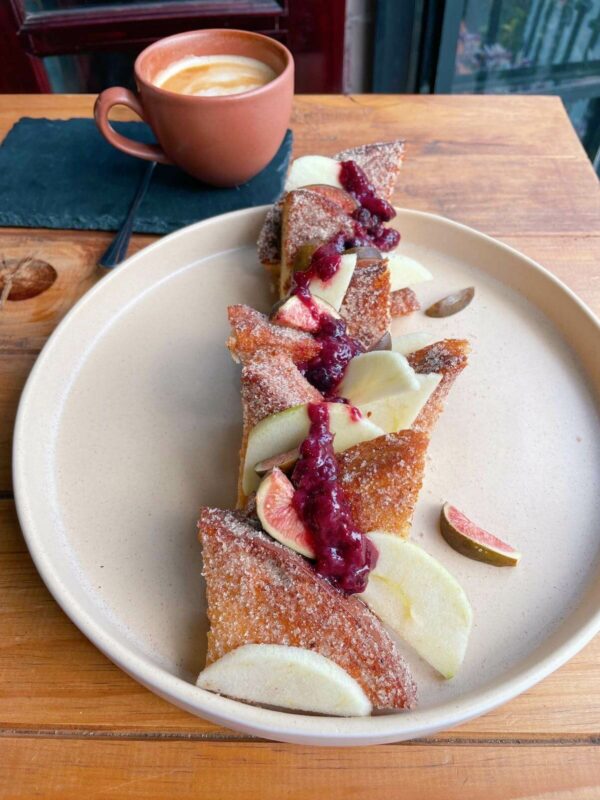
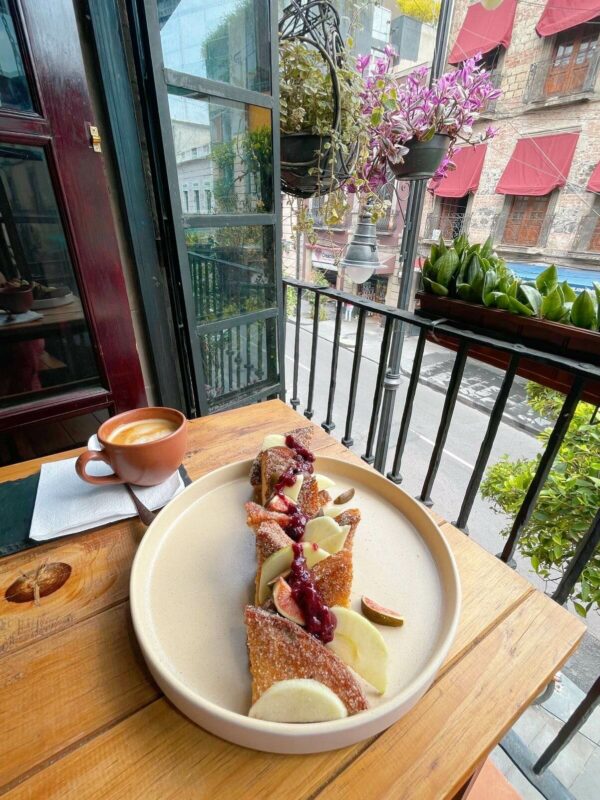
This hidden gem is my personal favorite place for specialty coffee in Centro and somewhere I’ve mentioned in several blog posts now. Casiopea serve the best coffee around (and it’s stronger than at Balam) alongside brunch dishes like French toast.
It’s hidden away above an art shop on a quiet street so it’s never too busy.
Museo Mexicano del Diseno
On the main walking street leading to Tenochtitlan, MUMEDI is a cool ‘design hotel’ with a cafe and funky gift shop. They serve decent coffee and lunch dishes. The perfect place to duck away from the crowds and enjoy a cappuccino in modern settings!
Desserts and pastelerias in the Historic Center
Unlike the boujee bakeries in Condesa serving sourdough and other modern bites, the pastelerias of Centro have been churning out the same classic treats for decades.
These fantastic historic establishments are a treat in themselves to visit…
Dulceria de Celaya
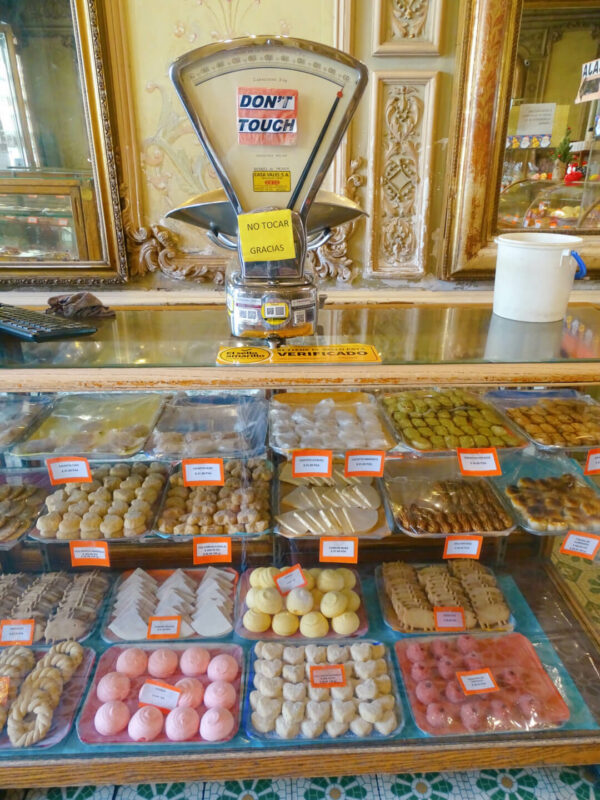
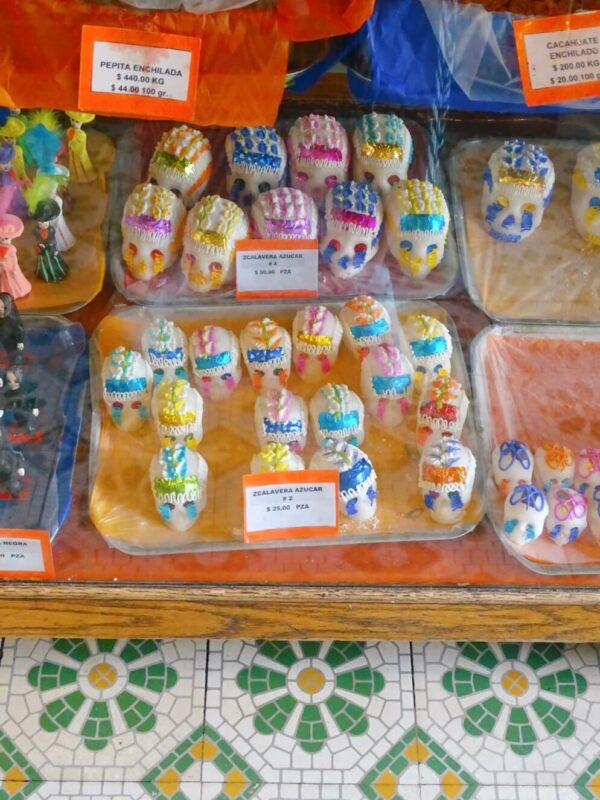
This historic sweet shop open since 1874 is one of the oldest in the city and easily the most beautiful. Dulceria de Celaya make confectionary according to 150 Mexican recipes from all areas of the country. With tiled floors and traditional decor, it’s worth peeking inside… and buying some sweet treats from 20 pesos.
Pasteleria Ideal
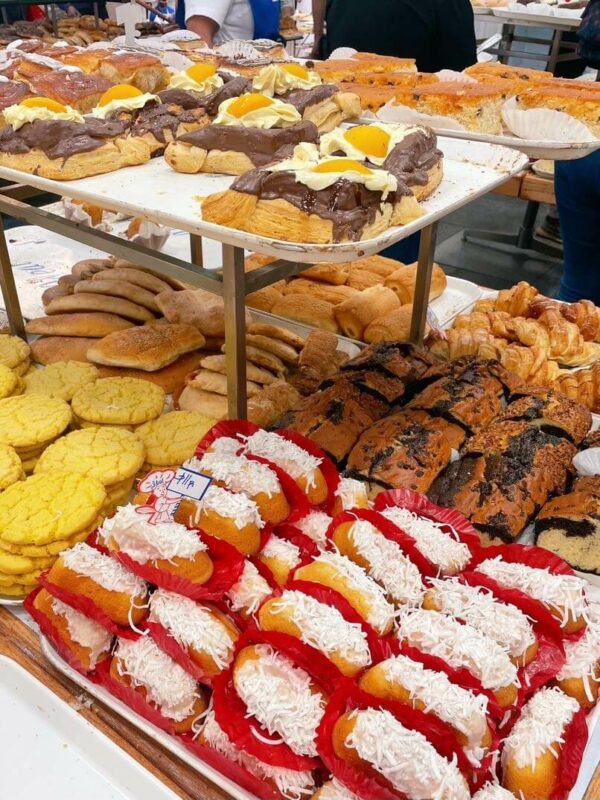
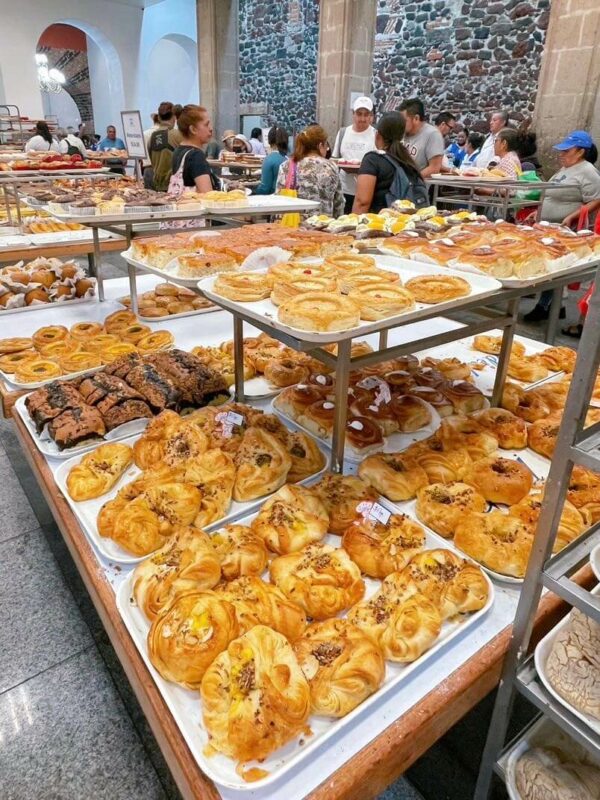
To call Pasteleria Ideal a bakery would be an understatement: it’s more like a decadent palace, bustling with people, and full to the brim with every kind of cake imaginable! Even if you’re not going to buy (although I can’t think why you wouldn’t), it’s worth a visit when visiting Mexico City’s Centro.
From giant birthday cakes from 300 pesos to baked goods like croissants, pastries, conches, cream cakes, and cookies from 10 pesos, there’s so much choice.
The buying process goes like this: grab a tray, choose your cakes, go to the counter, and give them to a member of staff in exchange for a ticket. Take this to the payment counter and get a new ticket once you’ve paid, then return to the first counter where your cakes will be bagged up and ready to go. A bit confusing but worth it!
There are two in Centro; one on 16 de Septiembre and one on Uruguay. I don’t think you can go wrong with either.
Churros El Moro
The most famous place for dessert in the Historic Center is not up for debate. Churros el Moro is another classic cafe open since 1935.
Nowadays, there are several branches of El Moro in the city but most are modern-style cafes such as the one by Parque Mexico in Condesa. The Centro cafe couldn’t be more different. With stained glass windows and staff wearing traditional uniforms, it’s barely changed in 100 years.
It brings churros and hot chocolate to the people of Mexico City, 24 hours a day. I’d recommend dining in to enjoy the atmosphere. Eat your churros as soon as you get them; they’re never good cold!
Rooftop bars with views of Centro Historico
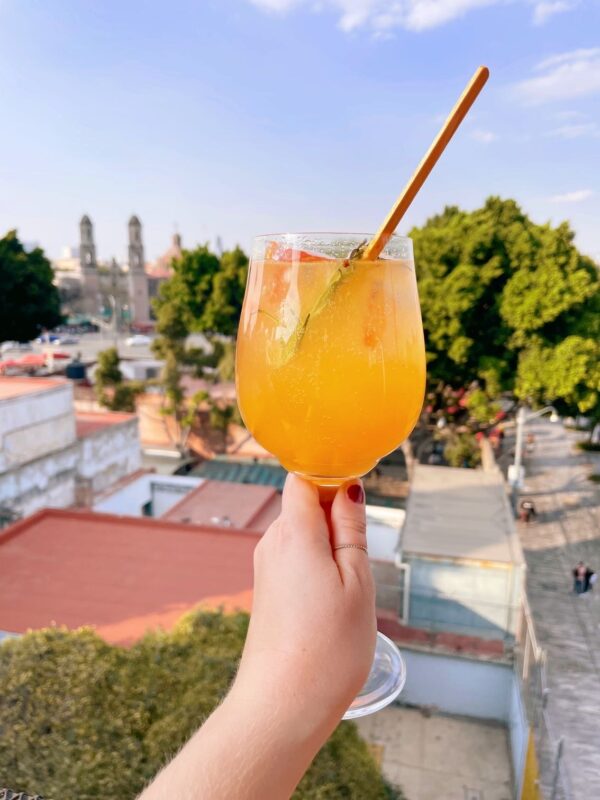
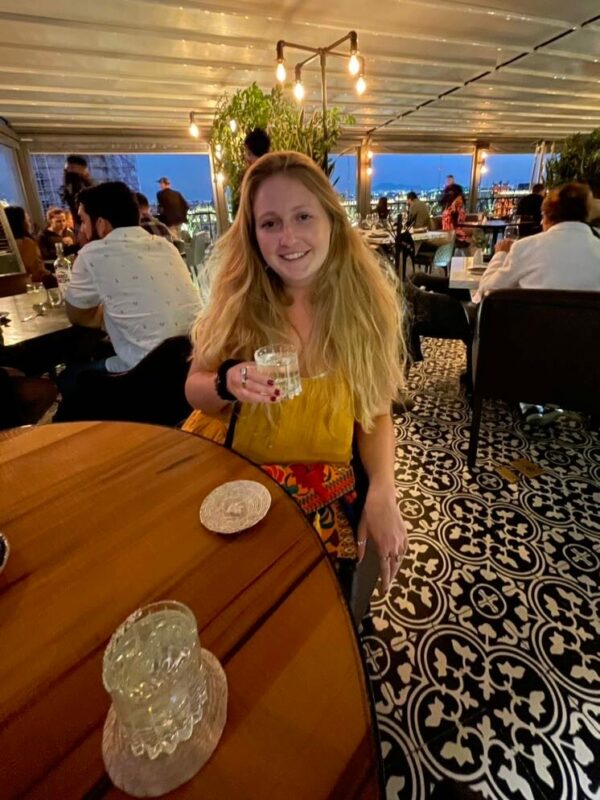
After a busy day sightseeing, an afternoon (or sundowner) drink on a terrace may be just what you need. I can personally vouch for…
La Azotea
Beside Alameda Park, this is a lovely rooftop with shady seating and a wide range of snacky foods, plus main meals like sandwiches and burgers, alongside refreshing cocktails for 150 pesos. I like the gin and grapefruit one.
Balcon del Zocalo
Treat yourself to dinner and cocktails at this upscale bar and restaurant. From Balcon del Zocalo’s terrace area, you have great views of Centro. You can’t sit there but you can wander outside after your meal to enjoy the scenery.
Read next: 35+ bars in Mexico City for every occasion
More bars in the Historic Center
For a late-night vibe, visit…
Zinco Jazz
Zinco Jazz Bar is a cool, retro-themed bar with a speakeasy entrance. They have regular themed nights (check the website to see what’s on) with entry from 300 pesos.
Bosforo
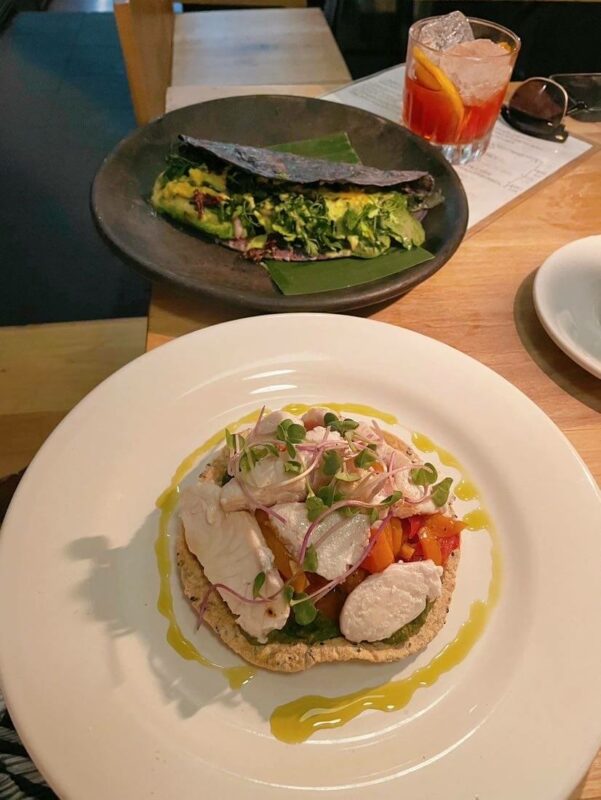
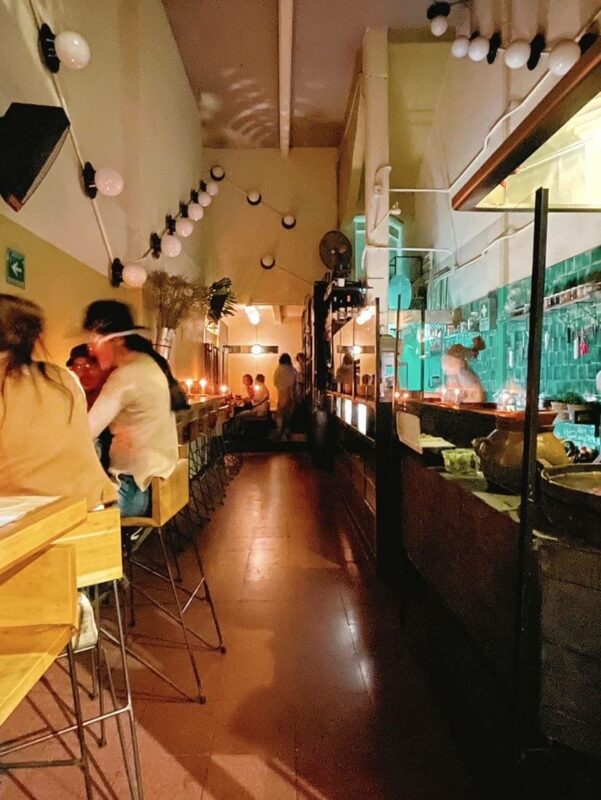
There are two Bosforo establishments next door to one another: a lively mezcal bar (enter from the street through a huge curtain) that’s packed on weekends, and an intimate restaurant serving quality Oaxacan food. Both places are excellent and not overpriced.
Itinerary for 1 day in Centro
8.30am: get breakfast at Cafe Tacuba or El Cardenal (the reason I suggest going early is to visit the National Palace in time for the 10.30am tour. If you’re not planning on going, start your day whenever)
9.45am: get in line for the National Palace
11.30am: visit another museum or gallery such as Bellas Artes, MUNAL, or the Popular Art Museum. Swing by the Postal Palace and Casa de Azulejos as they don’t take long
1.30pm: get tacos at Los Cocoyos or Tacos Ricos Toluca (or both!) and dessert at Pasteleria Ideal or Dulceria de Celaya
2.30pm: visit another museum or gallery or have an afternoon drink at Finca don Porfirio cafe for the best views of Bellas Artes
4pm: head up the Torre Latinoamericana (if you’d prefer a sundowner drink, leave this ’til a bit later)
7pm: head for dinner at Bosforo (stay for the mezcal bar next door if you’re a fan) or any of the other restaurants in Centro. Catch a jazz show at Zinco if you have the energy!
Safety in Centro
Mexico City’s Centro Historico is safe provided you stick to the main areas and tourist attractions. It borders Doctores on one side and Tepito and La Lagunilla Market on the other (places best avoided for foreigners) so be sure you don’t wander into these by mistake.
Take the same precautions you would anywhere like not flashing your valuables. Walking around in Centro is best avoided after dark; I’d take Uber or Didi instead.
Overall, don’t be scared by the chaotic vibe. If it’s something you’re not used to, you may feel uncomfortable but don’t confuse this with unsafe. So, relax and enjoy your day!
FAQs
What is the central square of Mexico City called? The central square in the heart of the Zocalo is called Plaza de la Constitución. You can’t miss the giant flag that’s put up and taken down every morning and evening.
What does Zocalo mean in English? This refers to the main square at the heart of any Mexican town or city.
What are the top attractions in the center of Mexico City? Palacio de Bellas Artes, Templo Mayor, the Metropolitan Cathedral, and Torre Latinoamericana are the most famous places to visit for tourists. My personal favorite places are the Museum of Popular Art and the National Palace for its spectacular Diego murals.
Thanks for reading!
I hope you have a better idea of what to do in Centro Historico and you have an amazing time exploring! It’s a fascinating place that could keep you busy for days.
Mexico City food and drink guides:
- Best breakfast and brunch in Mexico
- Where to find the best coffee in CDMX
- Cafes in Condesa
- Cocktail bars in CDMX
- Vegan restaurants in Mexico City
Mexico City neighborhood guides:
Other Mexico City guides:
- Visiting Saturday’s San Angel Market
- A day trip from Mexico City to Tepotzotlan
- Hiking in Desierto de los Leones National Park

